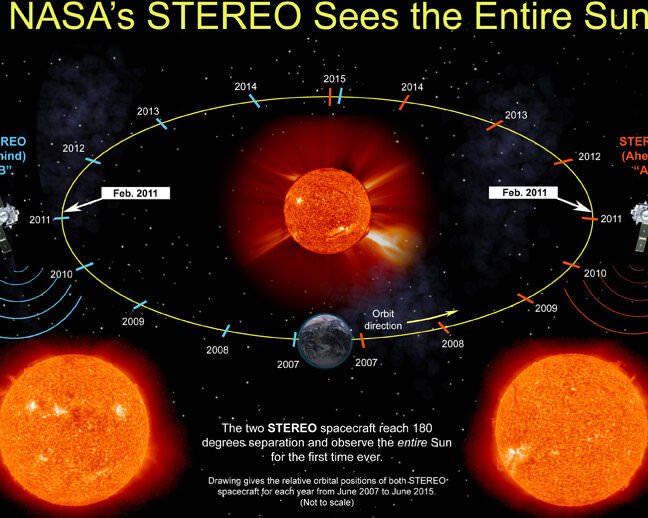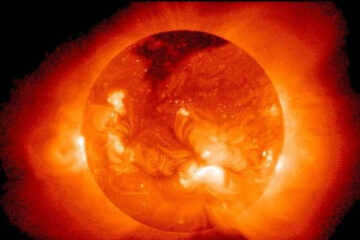
The Sun, the central star of our solar system, is known for orbiting in various paths around which all the planets revolve. It has been around for approximately 5 billion years and is classified as a yellow dwarf, meaning it is relatively small in size. Unlike other stars, the Sun’s thermonuclear reactions occur at a slow pace, allowing it to maintain its energy for an extended period of time. However, it is important to note that the Sun’s life cycle is only halfway complete. In the next 5 billion years, the balance of gravitational forces will shift, causing the star to expand in size and gradually increase in temperature. As a result of thermonuclear fusion, all of the Sun’s hydrogen will eventually be converted into helium. During this stage, the star will be three times its current size. Over time, the star will cool down and eventually extinguish. Presently, the Sun is primarily composed of hydrogen (90%) with a small percentage of helium (10%).
At present, there are 8 planets revolving around the Sun, in addition to numerous comets and asteroids. Each of these celestial bodies follows its own unique orbit. It is worth noting that when the combined mass of all the satellites of the Sun is calculated, it is found to be 1000 times less than that of the star itself. Therefore, it is important to study the major celestial bodies in this system in greater detail.
A general understanding of the solar system
To comprehend the satellites of the Sun, it is essential to acquaint oneself with the definitions: what constitutes a star, planet, satellite, and so on. A star is a celestial body that emits light and energy into space. This phenomenon is made possible by thermonuclear reactions and compression processes occurring within it due to the force of gravity. In our solar system, there is only one star, which is the Sun. Surrounding it are eight planets.
Presently, a planet is a celestial object that revolves around a star and possesses a roughly spherical shape. Unlike stars, planets do not emit light; rather, they can reflect it. Furthermore, there are no other significant celestial bodies in close proximity to the planet’s orbit.
A satellite is an entity that revolves around other stars or larger planets. Its orbit is maintained by the gravitational force exerted by this massive celestial body. In order to grasp the number of satellites that the Sun possesses, it must be recognized that this roster encompasses not only planets, but also asteroids, comets, and meteorites. Identifying them individually is a nearly insurmountable task.
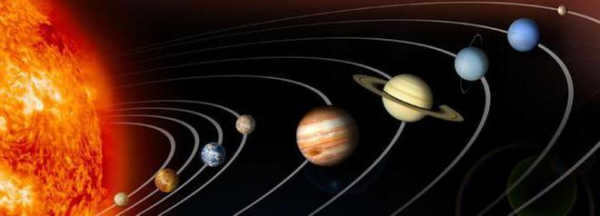
Previously, it was commonly believed that our solar system consisted of 9 planets. However, after extensive deliberation, Pluto was excluded from this list. Nonetheless, it still remains a part of our solar system.
The sun governs the orbits of 8 major planets. Additionally, a planet can also have celestial bodies revolving around it. These celestial bodies can be quite sizable. The planets are categorized into 2 groups. The first group comprises the inner satellites of the Sun, while the second group consists of the outer satellites.
The planets belonging to the terrestrial group are as follows:
- Mercury (which is the closest to the sun).
- Venus (known as the hottest planet).
- Earth.
- Mars (considered the most accessible object for exploration).
These planets are primarily composed of metals and silicates, and they possess solid surfaces. On the other hand, the outer group consists of gas giants, including:
These gas giants have a composition that is rich in hydrogen and helium. They hold the title for being the largest planets in the entire solar system.
The Moons of the Gas Giants
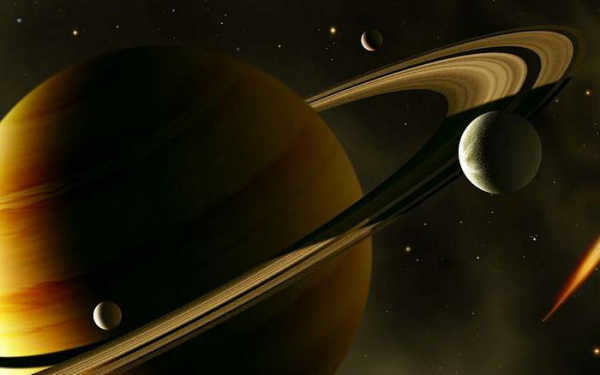
When considering the number of satellites that orbit the Sun, it is important to mention the celestial bodies that orbit the planets. In ancient Greece, the planets were known to be Venus, Mercury, the Sun, Mars, the Moon, Jupiter, and Saturn. Earth was later added to this list in the 16th century. The Sun holds a central position in our understanding of the solar system. The Moon, on the other hand, is a satellite of Earth.
Advancements in technology have revealed that almost all planets have their own satellites, with the exception of Venus and Mercury. Currently, there are approximately 60 known satellites of the planets, each varying in size. The smallest satellite, Leda, has a diameter of only 10 km and belongs to Jupiter.
Many of these celestial objects revolving around the gas giants were detected using automated space technology, which supplied scientists with images of these entities.
Mercury and Venus
Our star has two relatively diminutive entities. The solar satellite Mercury is the tiniest planet in the system. Venus is slightly bigger than Mercury, but neither of these planets possesses any natural satellites.
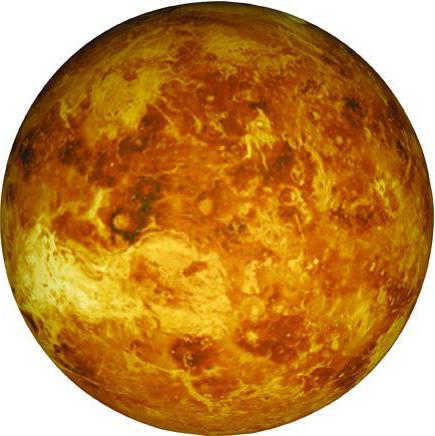
Mercury possesses a highly rarefied atmosphere composed mainly of helium. It completes its orbit around the Sun in 88 Earth days. However, its rotational period, or the time it takes for the planet to complete one full rotation on its axis, is 58 days as per our Earth standards. On the side directly facing the Sun, the temperature can reach a scorching +400 degrees. On the night side, the temperature drops significantly to a chilling -200 degrees.
Venus, on the other hand, has an atmosphere primarily composed of hydrogen with traces of nitrogen and oxygen. This planet experiences a greenhouse effect, resulting in extreme surface temperatures that reach a staggering 480 degrees, surpassing even that of Mercury. Venus is particularly visible from Earth due to its close proximity to our planet in terms of its orbit around the Sun.
Planet Earth
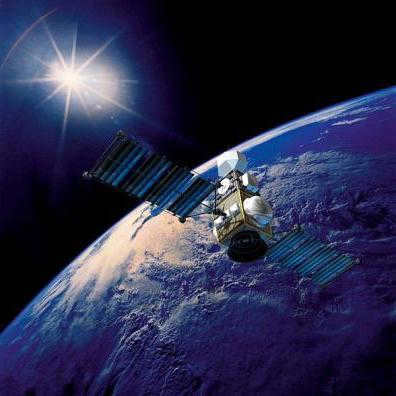
The Earth is the largest planet in the solar system. It stands out among the first four planets orbiting the sun due to its moon, which is the largest celestial body in this group. Unlike the other planets, Earth has a unique atmosphere that supports life.
About 71% of Earth’s surface is covered in water, while the remaining 29% is land. The atmosphere is primarily composed of nitrogen, but it also contains oxygen, carbon dioxide, argon, and water vapor.
The Earth’s natural satellite, the Moon, lacks an atmosphere. It is devoid of wind, sound, and the passage of time. Its surface is composed of rugged terrain riddled with craters. On our planet, the impact sites left by meteorites are gradually eroded by the forces of life, wind, and weather. Conversely, on the Moon, there is no such activity. As a result, any remnants of its history are preserved with remarkable clarity.
Mars
The Red Planet, also known as Mars, is a fascinating celestial body in our solar system.
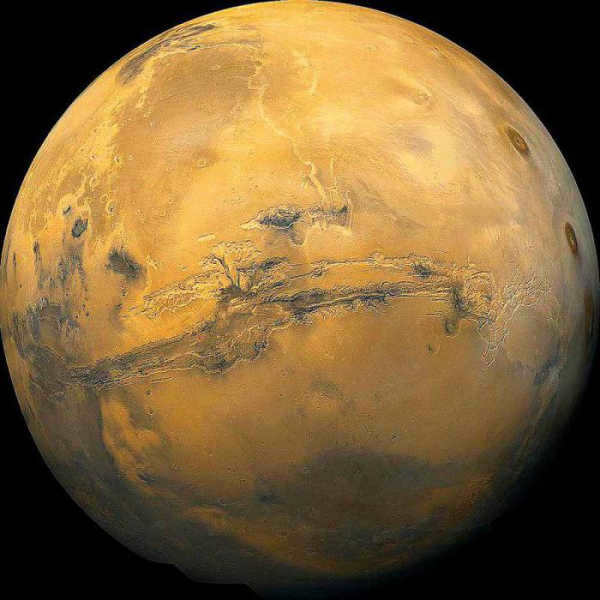
It functions as the trailing celestial body of the earth cluster. It gains the moniker of the “Red Planet” due to its elevated iron oxide composition in the ground. It is rather comparable to the Earth’s satellite. It revolves around the sun for a duration of 678 Earth days. Scientists had speculated that life might have potentially thrived in this location. However, research has not been able to substantiate this claim. The satellites of Mars are Phobos and Deimos, both of which are smaller in size than the moon.
It possesses a colder climate compared to our planet. At the equator, the temperature can climb up to 0 degrees, while at the poles, it plummets to -150 degrees. This celestial body is already within reach for astronauts, as a spaceship can reach it within a span of four years.
In the past, the Earth’s surface was covered with flowing rivers. It was filled with water. However, today, the poles are covered with ice caps. Interestingly, these ice caps are not composed of water, but of carbon dioxide that comes from the atmosphere. Scientists believe that the water might have been frozen in massive blocks beneath the surface of the planet.
Gas giants
The gas giants are celestial bodies that lie beyond Mars in our solar system. These planets, which are satellites of larger planets in this group, have been extensively studied using various scientific methods. The largest gas giant in our solar system is Jupiter, which is approximately 2.5 times more massive than all the other planets combined. Composed mainly of helium and hydrogen, similar to our Sun, Jupiter also emits heat. However, in order to be classified as a star, Jupiter would need to be approximately 80 times more massive. Additionally, Jupiter has a total of 63 satellites.
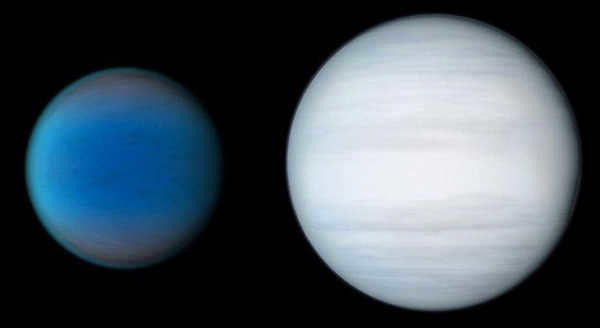
Jupiter is bigger than Saturn, but Saturn is not far behind in size. One distinctive feature of Saturn is its magnificent rings, which are composed of icy particles of different sizes. The planet’s density is lower than that of water, making it one of the least dense planets in our solar system. Saturn is also home to a remarkable number of satellites, with a total of 62 orbiting around it.
As we move further away from the Sun, we encounter Uranus and Neptune. These two planets, which are even more distant than Saturn and Jupiter, were first discovered using telescopes. They are classified as ice giants due to their high concentrations of ice with extreme temperature variations. Uranus boasts an impressive collection of 23 moons, while Neptune has 13 moons of its own.
Pluto
Pluto, a small object orbiting the Sun, was once classified as a planet from 1930 to 2006. However, scientists have since determined that it does not meet the criteria to be considered a planet and instead falls into the category of dwarf planets. The surface of Pluto is covered in frozen methane and nitrogen ice. It has one satellite.
When studying the Sun’s main satellites, it becomes apparent that they form a complex system consisting of various objects with different characteristics and indicators. Despite their differences, all of these objects are bound together by the force that compels them to orbit their central star.
Other relevant information:
The secrets of our celestial body are vast. In order to determine whether the Sun is classified as a star or a planet, it is necessary to gain an understanding of the formation and composition of both celestial entities.
The Formation of Stars
Stars are colossal conglomerates of gas that are held together by the gravitational force they generate. Within their core, intense thermonuclear fusion reactions occur, resulting in the emission of immense amounts of energy. The initial formation of stars can be traced back to the aggregation of gas and dust particles. These particles collided with one another, progressively forming larger and larger entities. Consequently, as the entities grew in size, they began to exert a stronger gravitational pull, attracting additional particles.
These potential future stars went through a process of being warmed by the continuous impact of dust and larger objects. Over time, their gravitational pull caused a collection of gases to form around them, resulting in an increase in temperature. Subsequently, the initial thermonuclear reaction took place, leading to the star’s first illumination! The remaining gases and dust then shaped into a disk encircling the developing star.
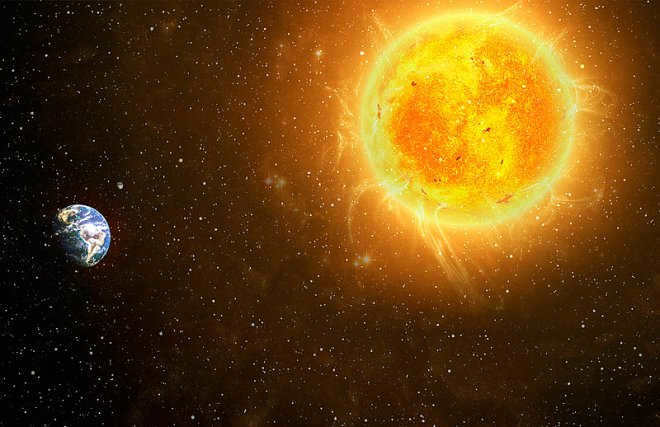
How planets form
After a star is formed, it leaves behind a significant amount of debris. This debris, consisting of gas and dust, forms a rotating disk around the star due to gravitational forces. Over time, the dust particles within the disk collide and merge, forming larger objects. These objects experience constant collisions, resulting in heating. Initially, the planets resemble molten lava masses that gradually cool and develop a rocky crust. Alternatively, some planets accumulate gas clouds around them, transforming into gas giants.
At the inception of the solar system, there existed numerous planets that engaged in a chaotic ballet around their celestial body, engaging in collisions, collapses, and mergers. The smaller fragments were drawn towards the larger entities, assimilating into their structure. Meanwhile, other fragments were flung towards the outer edges of the system, joining together to form the asteroid belt that persists to this day. Ultimately, whatever remnants remained within the confines of this belt were subject to the gravitational pull of the planets.
What is the Sun?
Now we have discovered that our Sun is part of the stellar family. However, what exactly is our celestial body and what is its composition?
The Sun primarily consists of hydrogen and helium, with trace amounts of other substances. At its core, thermonuclear reactions occur. Due to its immense gravitational force, it takes hundreds of thousands of years for a photon from the Sun’s core to travel to its surface. In some cases, this journey can take millions of years. Once the photon reaches the surface, it only takes a mere eight minutes for it to reach Earth. Consequently, every day we witness light that originated within the Sun’s interior hundreds of thousands of years ago.
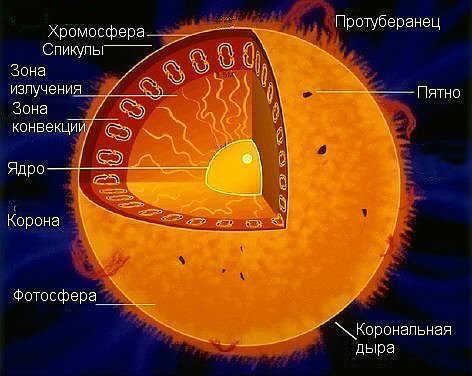
The composition of the Sun
The temperatures of the Sun’s surface and core vary by millions of degrees. The Sun’s outer layer, known as the corona, is filled with energetic eruptions and prominences. Strong eruptions release a stream of electrons, protons, neutrinos, and other particles. When these particles interact with the Earth’s magnetic field, they create a magnificent natural phenomenon – the aurora borealis!
The Sun is a remarkable celestial object that illuminates our lives. The entire solar system, including our planet and ourselves, is composed of the gas and dust particles that originated from the Sun. However, in the grand scope of the Universe, the Sun is just a small star, classified as a Yellow Dwarf. Nevertheless, it holds great significance and closeness to each and every individual!
32 percent of Russians believe that the Earth revolves around the Sun, according to a recent poll conducted by VTsIOM for the Day of Russian Science. This is an increase from the 28 percent who held this belief in 2007. The poll also revealed that 8 percent of Russians do not believe that the center of the Earth is hot and 11 percent believe that boiling milk can make it safe from radiation. Additionally, 55 percent of respondents think that all radioactivity on Earth is man-made and 78 percent agree that oxygen on Earth comes from plants. The poll also found that 52 percent of Russians believe that electrons are smaller than atoms, and 46 percent think that antibiotics are equally effective against both bacteria and viruses. Only 20 percent of Russians agree that the sex of a child is determined by the genes of the mother. The poll also showed that 29 percent of Russians believe that humans and dinosaurs coexisted on Earth, and 61 percent believe in the theory of evolution. The poll was conducted from January 29 to 30, 2011, and surveyed 1.6 thousand people in 138 settlements in 46 regions, territories, and republics of Russia.
In addition to the poll results, it is interesting to note that there are some misconceptions about history held by British schoolchildren. For example, some believe that Winston Churchill was the first man to land on the moon, while others think that Adolf Hitler was the Prime Minister of Great Britain during World War II. These unconventional views of historical events are not limited to young residents of Great Britain, as numerous surveys have shown that many people around the world hold strange beliefs about various subjects.
In terms of astronomy, about a third of British school students mistakenly believe that the Earth is a satellite of the Sun. Meanwhile, in Russia, 30 percent of residents think that the Sun revolves around the Earth. The majority of Americans, however, correctly believe that the Earth revolves around the Sun. Some Russians also equate the Sun and the Moon in terms of their status. Furthermore, 60 percent of Eurasian residents believe that the Earth completes one revolution around the Sun per month. When it comes to the number of planets in the solar system, about 10 percent of Americans can accurately answer this question. Mars seems to be a source of doubt, with two out of five British schoolchildren thinking it is a candy bar.
In the field of biology, there are differing beliefs about the theory of evolution. While 53 percent of Americans believe that all species appeared as we know them today, 31 percent think that evolution occurred but was driven by God’s will, and only 12 percent agree with Charles Darwin’s view. In Russia, only half of citizens have heard of the theory of evolution. Additionally, a quarter of Europeans and a third of Russians believe that humans appeared on Earth at the same time as dinosaurs. The sex of a future child is believed to be determined solely by the mother’s genes by less than half of Russian residents and over 60 percent of Europeans.
In terms of geography, there are some knowledge gaps among young Americans. For example, 95 percent of them do not know the location of Afghanistan, and three-quarters of them struggle to locate Israel, Iraq, and Iran on a world map. Some Americans even believe that Chechnya borders Serbia. Additionally, many Americans are unfamiliar with the geography of their own country, with half of them not knowing the location of New York City. Similar struggles exist in Russia, with three-quarters of Russian citizens unable to name the capital of Portugal and half being uncertain about whether Holland and the Netherlands are one country or two. The highest mountain on Earth, Everest, is incorrectly believed by one in three UK residents to be located in the European or UK mountains.
When it comes to history, many people have a limited understanding. For example, a significant number of young Americans and Englishmen believe that their countries were the ones to victoriously enter Berlin in an unknown year during World War II. There is also confusion about who was the first to visit the Earth’s satellite, with 40 percent of Russians unsure and 6 percent believing it was a Soviet cosmonaut. Furthermore, 60 percent of Russians could not explain what the February Revolution was, and 30 percent are unaware of the significance of February 23 and March 8 as holidays. Similarly, half of Americans are uncertain about why they have a day off on the Fourth of July, and one-fifth of those who do know it is Independence Day are unaware of what they are celebrating independence from.
In conclusion, while some misconceptions and lack of knowledge exist among certain populations, there are also many individuals who hold accurate beliefs about various subjects. It is important to continue educating and promoting scientific literacy to ensure a better understanding of the world we live in.
The primary star of our system, known as the Sun, is orbited by all the planets in various paths. It has an estimated age of 5 billion years. The Sun is classified as a yellow dwarf, indicating its relatively small size compared to other stars. It has a slow rate of consumption. The solar system is currently at approximately the midpoint of its lifespan. After 5 billion years, the balance of gravitational forces will be disrupted, causing the star to expand in size and gradually increase in temperature. This expansion will result in the conversion of all the Sun’s hydrogen into helium. At that point, the star will be three times its current size. Eventually, the star will cool down and contract. Presently, the Sun primarily consists of hydrogen (90%) and a small amount of helium (10%).
Nowadays, there are 8 planets encircling the Sun, attracting other celestial entities to orbit around them. Additionally, there exist numerous comets and a vast array of asteroids, all of which are in constant motion within their designated orbits. When the combined mass of these Sun’s satellites is calculated, it becomes apparent that they are 1000 times less massive than their central star. Furthermore, the significant celestial bodies within this system warrant a thorough examination.
A basic understanding of the solar system
In order to discuss the satellites of the Sun, it is important to first understand the definitions of certain terms such as star, planet, and satellite. A star is a celestial body that emits light and energy into space through thermonuclear reactions and gravitational compression. In our solar system, there is only one star, which is the Sun. Orbiting around the Sun are eight planets.
A planet is a celestial body that orbits a star and is generally spherical in shape. Unlike stars, planets do not emit light but can reflect it. Additionally, planets do not have any other large celestial bodies in close proximity to their orbits.
On the flip side, a satellite is an entity that orbits around larger stars or planets. Its orbit is maintained by the gravitational pull of the celestial body it revolves around. In order to grasp the number of satellites that the Sun possesses, it is important to acknowledge that this inventory encompasses not only planets, but also asteroids, comets, and meteorites. Attempting to tally them would be an exceedingly arduous task.
Planets
Until recently, it was widely accepted that our solar system consisted of nine planets. However, after extensive debate and consideration, the scientific community made the decision to exclude Pluto from the official list of planets. Nevertheless, despite its reclassification, Pluto remains an integral part of our solar system.
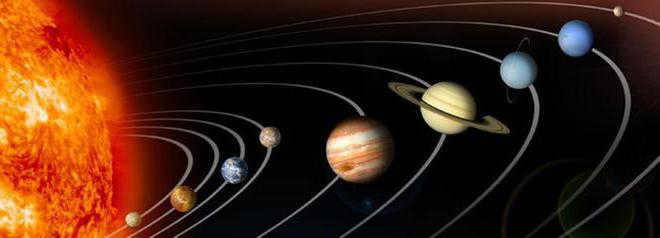
The Sun holds the 8 major planets in their respective orbits. A planet can also have other celestial bodies revolving around it, which can be quite large in size. All planets can be categorized into two groups: the inner satellites of the Sun and the outer satellites.
The terrestrial group, which belongs to the first category, consists of the following planets:
- Mercury (the planet closest to the Sun).
- Venus (known as the hottest planet).
- Earth.
- Mars (considered the most accessible object for exploration).
These planets are mainly composed of metals and silicates, and their surfaces are solid. On the other hand, the outer group consists of gas giants, which are characterized by a high concentration of hydrogen and helium. These planets resemble entire systems in themselves.
Satellites of planets
When discussing the number of satellites that orbit the Sun, it is important to consider the celestial objects that revolve around the various planets. In ancient Greece, the known planets were Venus, Mercury, the Sun, Mars, the Moon, Jupiter, and Saturn. It wasn’t until the 16th century that Earth was recognized as a planet as well. The Sun was understood to hold a central role in our solar system. Conversely, the Moon was discovered to be a satellite of Earth.
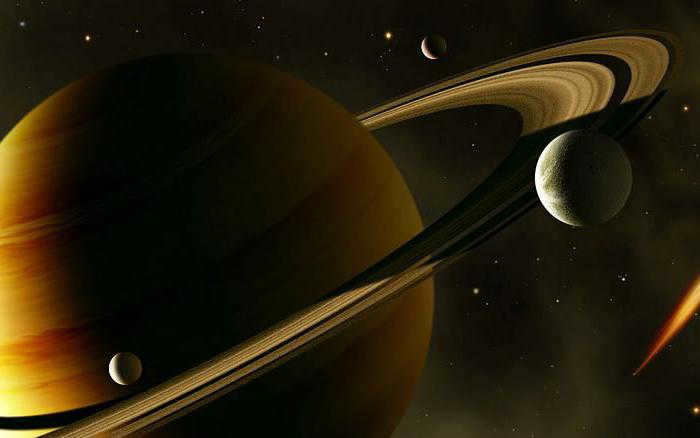
With the progress of technology, it has been revealed that nearly all planets possess their own satellites. Only Venus and Mercury lack them. At present, approximately 60 satellites of planets are recognized, which exhibit varying sizes. The tiniest known among them is dubbed Leda. This particular satellite measures a mere 10 kilometers in diameter.
The majority of such entities situated in the orbit of gas giants were unearthed using automated space technology. This technology furnished scientists with images of these celestial bodies.
Mercury and Venus
Two relatively small objects orbiting closest to our star are Mercury and Venus. Mercury is the smallest planet in our solar system and is a satellite of the Sun. Venus, on the other hand, is slightly larger. Interestingly, neither of these planets have any satellites orbiting around them.
Mercury has a very thin atmosphere composed mostly of helium. It completes a revolution around the Sun in just 88 Earth days. However, its rotation on its axis takes 58 days according to our standards. The temperature on the side facing the Sun can reach up to +400 degrees, while at night it can drop as low as -200 degrees.
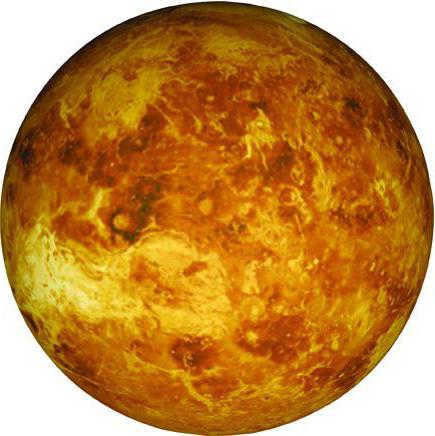
Venus has an atmosphere composed mainly of hydrogen, with traces of nitrogen and oxygen. This leads to the greenhouse effect, causing the surface temperature to reach an astonishing +480 degrees, even higher than that of Mercury. Due to its proximity to Earth, Venus is the planet that can be best observed from our vantage point.
Among all the members of the Earth group, our planet stands out as the largest. It possesses a number of distinctive features that make it truly unique. One of these features is Earth’s possession of the largest natural satellite among the first four planets from the Sun. This satellite, also known as the Moon, differs significantly from the satellites of other planets in terms of its atmosphere. It is this atmosphere that has played a crucial role in making life on Earth possible.
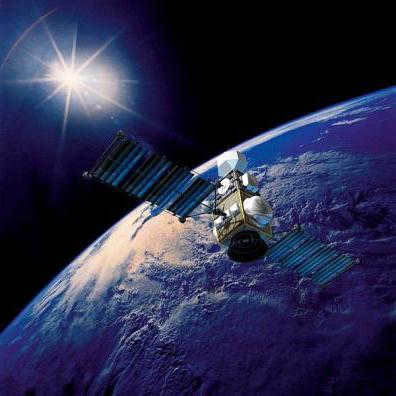
About 71% of the Earth’s surface is composed of water, while the remaining 29% consists of land. The Earth’s atmosphere primarily consists of nitrogen, but also contains oxygen, carbon dioxide, argon, and water vapor.
Unlike Earth, the Moon does not possess an atmosphere. It lacks wind, sound, and weather, resulting in a rocky and barren surface covered in craters. On Earth, the evidence of meteorite impacts is eroded over time by various factors such as species activity, wind, and weather. However, on the Moon, there is nothing to alter or conceal its past, making all traces of its history clearly visible.
Mars
This is the fourth planet in the Earth’s solar system. It is commonly referred to as the “Red Planet” due to its soil’s significant iron oxide content. Mars shares many similarities with Earth, making it a relatively Earth-like celestial object. It completes one orbit around the Sun in approximately 678 Earth days. Although there have been speculations about the possibility of past life on Mars, further research has yet to provide conclusive evidence. Mars has two natural satellites, Phobos and Deimos, both of which are smaller in size compared to Earth’s Moon.
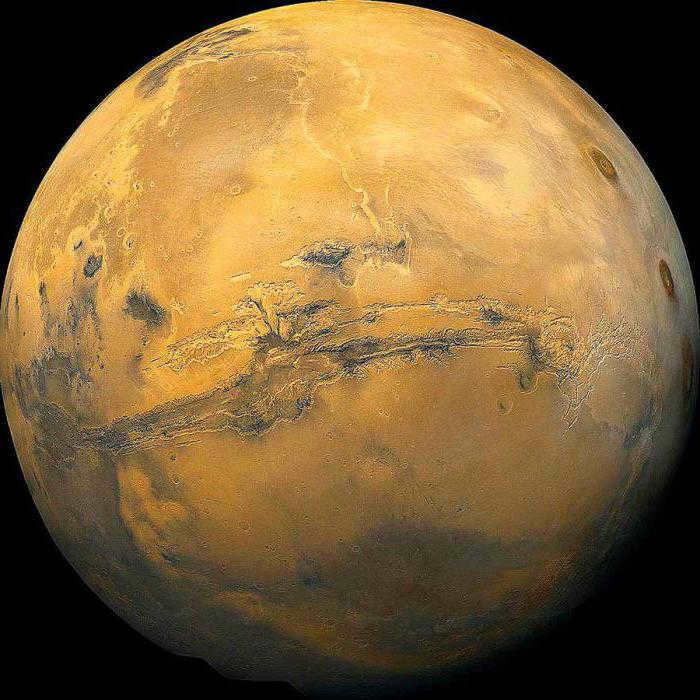
It is much colder on this planet compared to our own. The temperature at the equator can drop to 0 degrees, while at the poles it can reach as low as -150 degrees. Astronaut missions are already possible on this planet, and it would take approximately four years for a spaceship to reach it.
In the past, this planet had flowing rivers and water on its surface. However, now the poles are covered in ice caps. These ice caps are not composed of water, but rather of atmospheric carbon dioxide. Scientists speculate that there may be large blocks of frozen water beneath the planet’s surface.
Mars is home to the largest objects in the solar system that revolve around the Sun. The planets (which are satellites of the planets in this particular group) have been extensively studied using a variety of techniques. The largest object in our solar system is Jupiter, which is a whopping 2.5 times more massive than all the other planets combined. Composed primarily of helium and hydrogen, similar to our own star, Jupiter emits heat and radiation. However, in order to be considered a star, Jupiter would need to increase its mass by a factor of 80. Currently, Jupiter has 63 satellites orbiting around it.
Comparatively, Saturn is slightly smaller than Jupiter but is well-known for its magnificent rings. These rings are composed of icy particles that vary in size. Surprisingly, the density of Saturn is actually less than that of water. In total, Saturn has 62 satellites orbiting around it.
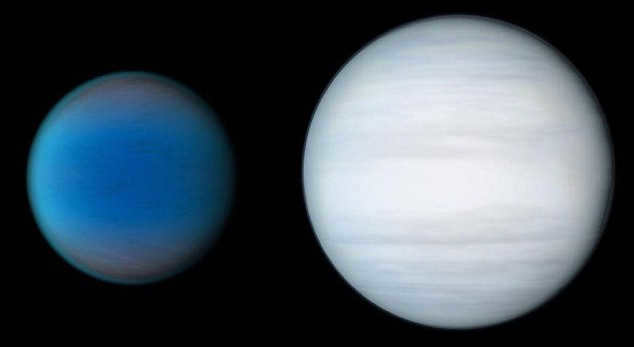
Uranus and Neptune are situated at a greater distance compared to the preceding two planets. Their discovery was facilitated by the utilization of a telescope. These celestial bodies consist of substantial quantities of ice in high-temperature forms. They are commonly known as the “Ice Giants.” Uranus is orbited by 23 satellites, while Neptune has 13 of them.
Pluto
The sun’s satellites are also complemented by a small object known as Pluto. From 1930 to 2006, it held the distinction of being classified as a planet. However, after extensive discussions, scientists reached the consensus that it does not meet the criteria to be considered a planet. Instead, Pluto falls into a different category. According to the current planetary classification, it is classified as a prototype. The surface of this object is covered in frozen ice composed of methane and nitrogen. Additionally, Pluto has one satellite.
When studying the main satellites of the Sun, it is important to note that they form a comprehensive system comprised of numerous diverse objects. These objects possess various characteristics and indicators. However, what unites all of these objects is the force that causes them to consistently orbit their central star.
The Earth is the center of the solar system, with the sun revolving around it. Alongside dinosaurs, humans existed during the same time period. Contrary to common knowledge, the core of the planet is actually cool. These are not the ramblings of a deranged individual or the incoherent statements of a young child. These are the beliefs held by adult Russians, as revealed in a VTsIOM survey conducted on the occasion of an obscure holiday – Science Day.
A staggering 32% of respondents, or one third of the population, confidently assert that the Sun is merely a satellite of the Earth. VTsIOM conducted this study in 146 different locations – could it be that by some extraordinary coincidence, sociologists encountered a disproportionately high number of ill-informed individuals? Or perhaps, it is simply the case that Russians have a penchant for humor and jest?
Resources about the subject
It appears to me that there is an absence of comedy in this situation. Many of us perceive the world around us in our own unique way, including those in positions of authority. Let’s consider, for instance, the unveiling of the scandalous bas-relief in Bryansk, where Konstantin Tsiolkovsky was unexpectedly transformed into Eduard, and the surname “Einstein” was distorted beyond recognition as “Enstien”.
After encountering such reports, it becomes somewhat concerning when Mr. Fursenko attempts to persuade journalists that physical education and OBL should be fundamental subjects in school. “They are related to health and safety, which are crucial in the study of any subject,” he informed Kommersant.
The situation is already alarming even without the introduction of the new education standard: a study conducted by the APRIORI research center in 2004 revealed that 15% of the population is unaware of the identity of Vladimir Lenin. School children mistakenly believe that he is a composer or “the president of Leningrad.”
Our Prime Minister has somewhat dampened the enthusiasm of the ministry with his cautionary statement: “Andrei Alexandrovich, there is currently a debate about new educational standards. You know how much I value sports and physical education, but if your experts have decided to make physical education the sole mandatory subject in schools, they have gone too far.”
It appears to me that it is premature to label Putin as a savior in this particular scenario. Every decision made within the government requires his awareness and approval. It is highly probable that the proposed new education standard and the potential elongation of the work week are merely additional tactics concocted by the White House PR team. Their intention is to provide their boss with the opportunity to publicly mock and discredit these foolish notions. As the Japanese proverb goes, a true leader crafts their own challenges and triumphs over them independently.
The Earth has only one natural satellite known as the Moon.
Among the planets closest to the Sun, only the Moon serves as a natural satellite, since Mercury and Venus lack satellites.
The Moon is composed of several layers, including a crust, upper mantle (asthenosphere), middle mantle, lower mantle, and core.
On the surface of the Moon, there is a layer of regolith, which is a mixture of fine dust and rocky debris formed from the impact of meteorites on the lunar surface.
The Slavonic word for “light” is Luna, which is used as the Russian name for the Moon. In Greek mythology, the Moon is referred to as Selene, while the ancient Egyptians called it Yah (Iyah), and the Babylonians named it Sin.
In 1984, during the Hawaiian Conference on Planetology, a theory called the Giant Collision Theory was collectively proposed to explain the origin of the Moon. According to this theory, the Moon was formed 4.6 billion years ago as a result of a collision between Earth and a celestial body named Teia.
The Orbit of the Moon
The Moon’s orbit has two key points:
- Perigee: the closest point to Earth, which varies between 356,400 and 370,400 kilometers, with an average distance of 363,104 kilometers.
- Apogee: the farthest point from Earth, which varies between 404,000 and 406,700 kilometers, with an average distance of 405,696 kilometers.
The average orbital velocity of the Moon is approximately 1.023 kilometers per second.
The Moon follows an elliptical orbit around the Earth, with a period of 27.32166 days. Over time, the Moon gradually moves away from Earth due to tidal acceleration at a rate of 38 millimeters per year, resulting in a slowly unwinding spiral orbit.
3D representation of the Moon
Physical properties of the Moon
The Moon is the solar system’s fifth-largest satellite.
The surface temperature of the Moon varies from -173 °C during the night to +127 °C at sunrise. Rocks at a depth of 1 meter maintain a constant temperature of -35 °C.
The average radius of the Moon is 1737.1 kilometers, approximately 0.273 times the radius of the Earth.
The Moon’s surface area measures 3.793 x 10 7 square kilometers.
The average density of the Moon is 3.3464 grams per cubic centimeter.
The acceleration of free fall on the Moon is 1.62 meters per second squared (0.165 g).
The mass of the Moon is 7.3477 x 10 22 kilograms.
Comparison of the Earth and the Moon in terms of size
The Atmosphere of the Moon
The atmosphere of the Moon is incredibly thin, consisting of small amounts of hydrogen, helium, neon, and argon.
When the surface is not exposed to sunlight, the concentration of gases above it is no more than 2 x 10 5 particles per cubic centimeter. However, after sunrise, it increases by a factor of one hundred due to the release of gases from the lunar surface.
Investigation of the Moon
In the 2nd century BC, Hipparchus delved into the movement of the Moon across the celestial sphere. He discovered the inclination of the lunar orbit in relation to the ecliptic, the Moon’s size and distance from the Earth, and identified various aspects of its motion.
Giovanni Riccioli created one of the earliest lunar maps in 1651, where he named the large dark areas as “seas”.
Astronomical observations took a new turn in the mid-19th century with the introduction of photography.
In 1959, the Soviet station Luna-3 provided the first glimpse of the far side of the Moon, capturing images of its surface that were previously unseen from Earth.
The American lunar mission program was known as Apollo. The initial landing occurred on July 20, 1969, while the final landing took place in December 1972. On July 21, 1969, Neil Armstrong, an American astronaut, became the first person to step foot on the Moon, followed by Edwin Aldrin. Michael Collins, the third crew member, remained in the orbital module.
Following the delivery of lunar soil samples to Earth by the Soviet station Luna-24 in August 1976, the Japanese Hiten satellite became the next spacecraft to fly to the Moon in 1990.
Currently, several lunar rovers and orbital probes from various nations are actively exploring the Moon.
The Moon stands as the sole extraterrestrial astronomical object that has been visited by humans.
The Moon’s gravitational pull causes the Earth’s oceans to experience tidal waves. The largest tides can be found in the Bay of Fundy in Canada, with a maximum amplitude of 18 meters.
Despite its own rotation, the Moon always presents the same face to the Earth. This synchronous rotation means that the Moon’s rotation on its axis is perfectly aligned with its orbit around the Earth.
Galileo Galilei discovered the phenomenon of libration in 1635, which allows us to observe about 59% of the lunar surface.
While the Moon lacks a global magnetic field like the Earth, it does have localized magnetic fields generated by magnetized rocks on its surface.
A Super Moon occurs when the Moon reaches its closest point to Earth (perigee) at the same time as its full phase.
Photographs of the Moon
An image capturing the flare that occurred on the Moon during the total eclipse on January 21, 2019
The central celestial body of our solar system, around which all the planets orbit, is referred to as the Sun. It is approximately 5 billion years old and classified as a yellow dwarf, meaning it is relatively small in size. The Sun’s consumption of energy is relatively slow, allowing it to maintain its current size for a significant period of time. The solar system is currently in the middle of its life cycle. In approximately 5 billion years, the gravitational forces within the system will become imbalanced, resulting in the Sun expanding in size and gradually increasing in temperature. This expansion will lead to the conversion of the Sun’s hydrogen into helium. At this point, the Sun will be three times its current size. Eventually, the star will cool down and shrink. Presently, the Sun is composed mainly of hydrogen (90%) and a small amount of helium (10%).
At present, there are 8 planets revolving around the Sun, along with numerous comets and a vast number of asteroids. Each of these celestial bodies follows its own unique orbit. When we combine the mass of all the Sun’s satellites, we find that they are significantly lighter than their central star, weighing only about one thousandth of its mass. It is worth examining the key celestial bodies within this system in greater detail.
A basic concept of the solar system
In order to understand the satellites of the Sun, it is important to become familiar with certain definitions: what constitutes a star, a planet, a satellite, and so on. A star is a celestial object that emits light and energy into space. This is made possible through thermonuclear reactions that occur within it, as well as compression processes influenced by gravity. Within our system, there is only one star, which is the Sun. Surrounding it are 8 planets that orbit it.
In modern times, a planet is defined as a celestial body that orbits a star and possesses a spherical (or nearly spherical) shape. Such objects do not emit light (unlike stars), but rather can reflect it. Additionally, a planet is not accompanied by other large celestial bodies within its orbit.
A celestial body that is much smaller than stars or planets and orbits around them is called a satellite. The gravitational force of the larger celestial body keeps the satellite in its orbit. When we consider how many satellites the Sun has, we need to take into account not only planets but also asteroids, comets, and meteorites. Counting all of them would be an almost impossible task.
Planets
Until recently, it was commonly accepted that our solar system consisted of 9 planets. However, after extensive deliberation, the scientific community decided to exclude Pluto from this list. Nevertheless, Pluto still holds a significant place in our solar system.

The Sun is responsible for keeping the 8 main planets in their respective orbits. It is also possible for a planet to have other celestial bodies orbiting around it. During space exploration, scientists often come across large objects. All the planets can be categorized into 2 groups. The first group consists of the inner satellites of the Sun, while the second group consists of the outer satellites.
The terrestrial planets, which belong to the first group, are:
- Mercury (the planet closest to the Sun).
- Venus (known as the hottest planet).
- Earth.
- Mars (considered the most accessible object for exploration).
These planets are primarily composed of metals and silicates, resulting in a hard surface. On the other hand, the outer group consists of gas giants, which are characterized by a high concentration of hydrogen and helium. They can be considered as complete systems on their own.
Satellites of planets
When discussing the number of satellites that the Sun has, it is important to note the celestial bodies orbiting the planets. In ancient Greece, the planets were believed to be Venus, Mercury, the Sun, Mars, the Moon, Jupiter, and Saturn. It was only in the 16th century that Earth was added to this list. The Sun has always held a central role in our solar system. Meanwhile, the Moon is a natural satellite of Earth.
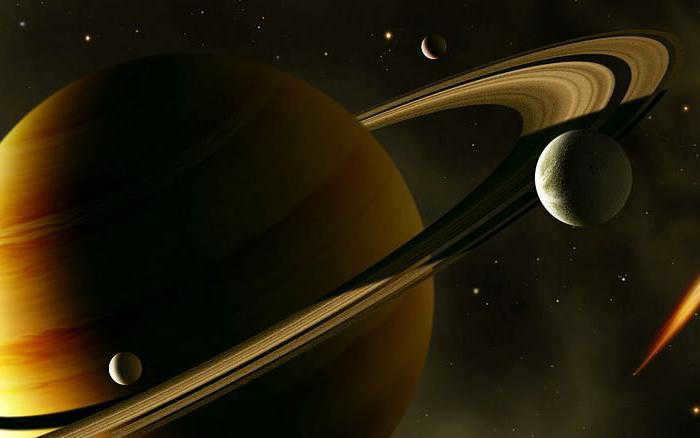
With the advancement of more sophisticated technology, it has been observed that nearly all planets possess natural satellites. Only Venus and Mercury do not possess them. Presently, around 60 satellites of planets are acknowledged, each characterized by varying sizes. The smallest known satellite is Leda, which has a diameter of a mere 10 kilometers.
The majority of these objects, situated in the orbit of gas giants, were detected using automated space technology, which furnished scientists with imagery of these celestial objects.
Mercury and Venus
Two relatively small objects have the closest proximity to our star. Mercury, a satellite of the Sun, is the tiniest planet in the system. Venus, on the other hand, is slightly larger than Mercury. However, both of these planets do not have any moons of their own.
Mercury possesses an extremely thin atmosphere consisting mostly of helium. It completes one orbit around its star in 88 Earth days. However, the length of its day, or the time it takes to rotate around its own axis, is 58 days by our standards. On the sunny side of Mercury, temperatures can reach a scorching +400 degrees, while at night, it cools down to a bone-chilling -200 degrees.
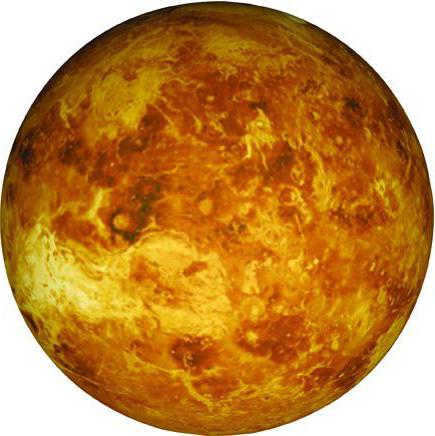
On Venus, the composition of the atmosphere is primarily hydrogen with traces of nitrogen and oxygen. This results in the greenhouse effect, leading to surface temperatures reaching a scorching +480 degrees. Surprisingly, this makes Venus hotter than Mercury. Due to its close proximity to Earth in terms of orbit, Venus is one of the most easily observable planets from our planet.
Earth
Out of all the celestial bodies in the Earth group, our planet Earth holds the distinction of being the largest. It stands out in numerous ways. Unlike the other three planets closest to the sun, Earth possesses a significant atmosphere. This unique atmosphere is what allows for the existence of life on our planet.

Approximately 71% of the Earth’s surface is comprised of water, while the remaining 29% consists of land. The predominant gas in the atmosphere is nitrogen, but it also contains oxygen, carbon dioxide, argon, and water vapor.
Unlike Earth, the Moon lacks an atmosphere, resulting in the absence of wind, sound, and weather. Its surface is rocky and barren, adorned with craters. On Earth, the effects of meteorite impacts are gradually erased by various processes such as the activity of organisms, wind, and weather. However, on the Moon, there is no such activity, which is why the remnants of its past are remarkably preserved.
Mars
Mars is the fourth planet in the solar system, and it is known as the “Red Planet” due to its soil’s high iron oxide content. It is a relatively Earth-like satellite that orbits the Sun in 678 Earth days. Scientists have speculated about the possibility of past life on Mars, but further research is needed to confirm this. Mars has two satellites, Phobos and Deimos, which are smaller than Earth’s Moon.
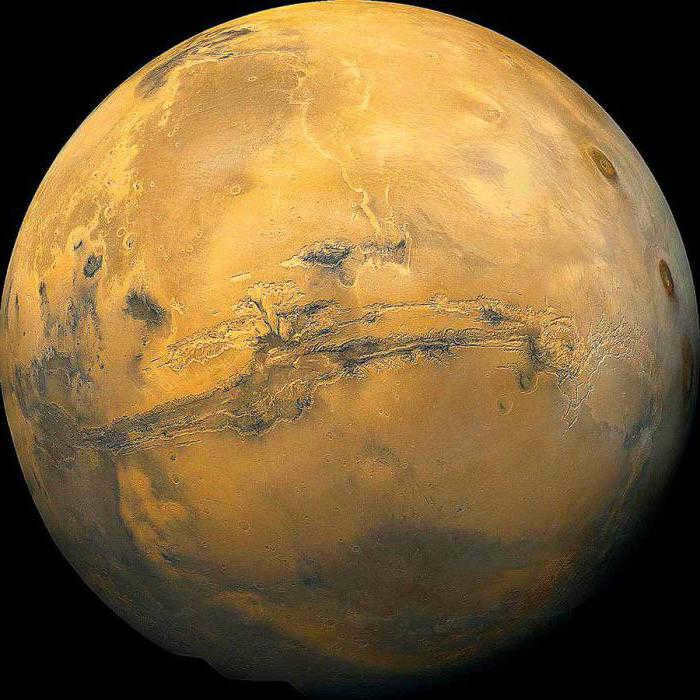
The temperature on this planet is colder compared to our own. It can drop to as low as -150 degrees at the poles, while at the equator it reaches 0 degrees. This extraterrestrial world is now open for astronauts to explore, with a spaceship being able to reach it in just 4 years.
In ancient times, rivers used to flow on the surface of this planet, indicating the presence of water. However, today, the water has transformed into ice caps located at the poles. Interestingly, these ice caps are not composed of water, but of atmospheric carbon dioxide. Scientists hypothesize that large blocks of frozen water may exist beneath the planet’s surface.
Gas giants in our solar system
Gas giants are the largest objects in our solar system that orbit the Sun. These planets, known as satellites, have been extensively studied using different methods. The largest gas giant in our system is Jupiter, which is 2.5 times more massive than all the other planets combined. Jupiter is primarily composed of helium and hydrogen, similar to our Sun. It emits heat, but it would need to be 80 times heavier to become a star. Jupiter has a total of 63 satellites.
Saturn, another gas giant, is slightly smaller than Jupiter but is famous for its magnificent rings. These rings are made up of icy particles with varying diameters. The density of Saturn is lower than that of water. It has a total of 62 satellites orbiting around it.
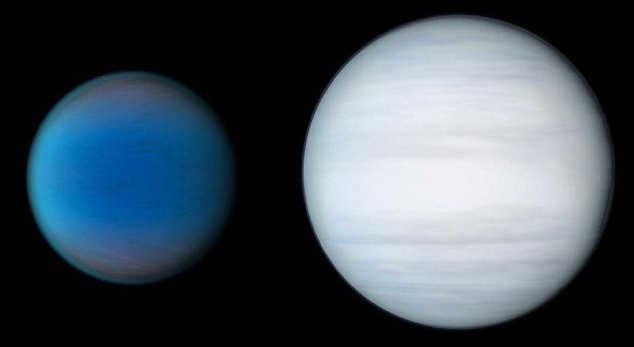
The planets Uranus and Neptune are situated at a greater distance from the Sun compared to the preceding two planets. Their existence has been observed and confirmed through the use of a telescope. These planets are composed primarily of ice in various high-temperature forms, earning them the nickname of “Ice Giants.” Uranus possesses a total of 23 satellites, while Neptune has 13 moons orbiting around it.
Pluto
The sun’s satellites are also accompanied by a small celestial body known as Pluto. From 1930 to 2006, it held the designation of a planet. However, after extensive discussions, scientists reached the consensus that it does not fit the criteria of a planet. Instead, Pluto falls into a distinct category. According to the current planetary classification, it is considered a prototype. The surface of this celestial object is covered with frozen methane and nitrogen ice. Pluto possesses one satellite.
When examining the primary satellites of the Sun, it is important to note that they form a complete system comprised of numerous diverse objects. Each object has its own unique characteristics and indicators. However, what unifies all these objects is the gravitational force that causes them to orbit consistently around their central star.
There are eight planets and over 63 satellites in the solar system, which are constantly being found. In addition, there are several dozen comets and a significant number of asteroids. Each of these celestial bodies follows its own unique path as it orbits around the Sun, which is 1000 times more massive than all the other objects in the solar system combined.
How many celestial bodies orbit the sun?
The formation of the planets in our solar system is believed to have occurred approximately 5-6 billion years ago. It is speculated that a disk-shaped cloud of gas and dust within the Milky Way galaxy began to condense and contract towards its center, eventually giving birth to the Sun. As a result of powerful gravitational forces, numerous particles of dust and gas that orbited the Sun started to merge together, ultimately forming what we now know as the planets. Alternatively, according to another theory, the gas and dust cloud fragmented into separate clusters, which then underwent compression and consolidation to give rise to the existing planets. Presently, there are a total of 8 planets continuously revolving around the Sun.
The Sun is at the center of the solar system, acting as a star that the planets orbit around. The planets themselves do not generate heat or light, but instead reflect the light emitted by the Sun. Currently, there are officially recognized 8 planets within our solar system. Let’s briefly list them in order of their distance from the Sun. Now, let’s move on to some definitions.
Planetary satellites are also a part of the solar system. This includes the Moon and the natural satellites of other planets, with the exception of Mercury and Venus. There are over 60 known satellites in total. Many of the satellites of the outer planets were discovered through photographs taken by automated spacecraft. Leda, the smallest satellite of Jupiter, measures only 10 kilometers in diameter.
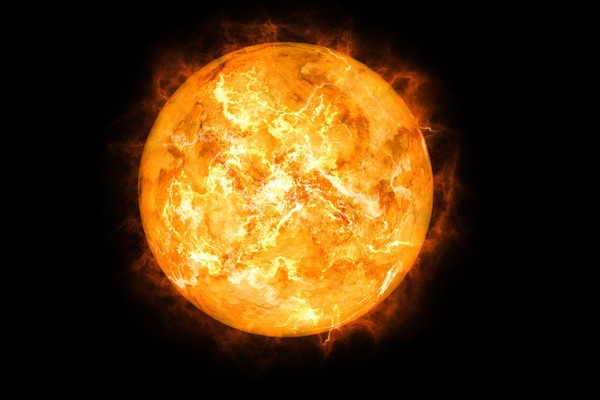
The Sun is an indispensable star for the existence of life on our planet. It provides us with essential energy and warmth. According to stellar classification, the Sun is classified as a yellow dwarf. It has been around for approximately 5 billion years. Its equatorial diameter measures 1,392,000 km, which is 109 times larger compared to the diameter of the Earth. The rotational period at the equator is 25.4 days, while at the poles it is 34 days. The Sun’s mass is approximately 2×10^27 tons, which is roughly 332,950 times heavier than the Earth. The core of the Sun has a scorching temperature of around 15 million degrees Celsius, while the surface temperature is about 5500 degrees Celsius.
The Sun is made up of 75% hydrogen, with helium being the most plentiful of the remaining 25% of elements. Let’s now explore how many planets orbit the Sun in our solar system, as well as the unique characteristics of each planet.
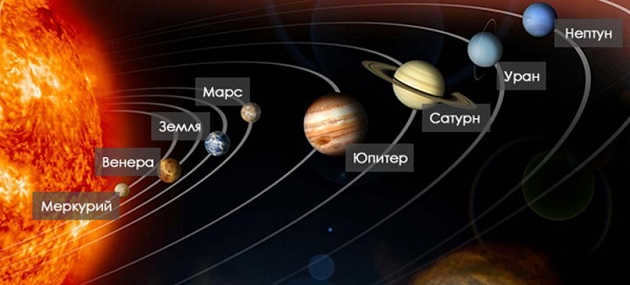
Pictures of the planets of the solar system in order from the sun
Mercury is the first planet in the solar system.
Mercury. The four inner planets (Mercury, Venus, Earth, and Mars) are the closest to the sun and have solid surfaces. They are smaller compared to the four giant planets. Mercury has the fastest movement among all the planets, experiencing scorching heat from the sun during the day and extreme cold during the night.
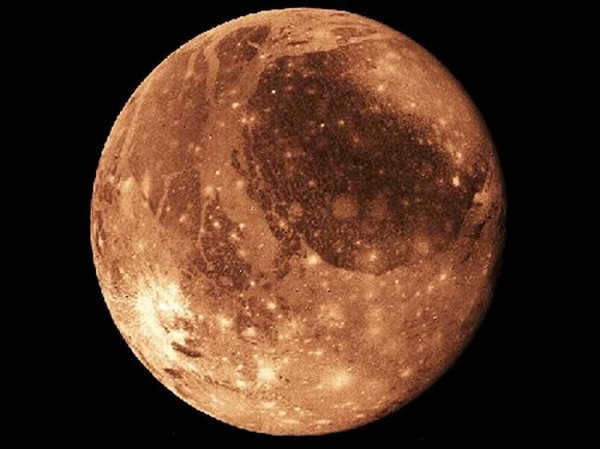
Mercury Planet Characteristics:
Orbit period around the Sun: 87.97 days.
Equatorial diameter: 4878 km.
Rotation period (spin around its axis): 58 days.
Surface temperature: 350 degrees during the day and -170 degrees at night.
Atmosphere: extremely thin, composed of helium.
Number of major satellites: 0.
Venus ranks second in terms of mass among all the planets in the solar system
Venus bears a closer resemblance to Earth in terms of size and brightness. However, its observation proves to be challenging due to the thick clouds that shroud its atmosphere. The surface of Venus is characterized by scorching temperatures and a rocky, desert-like terrain.
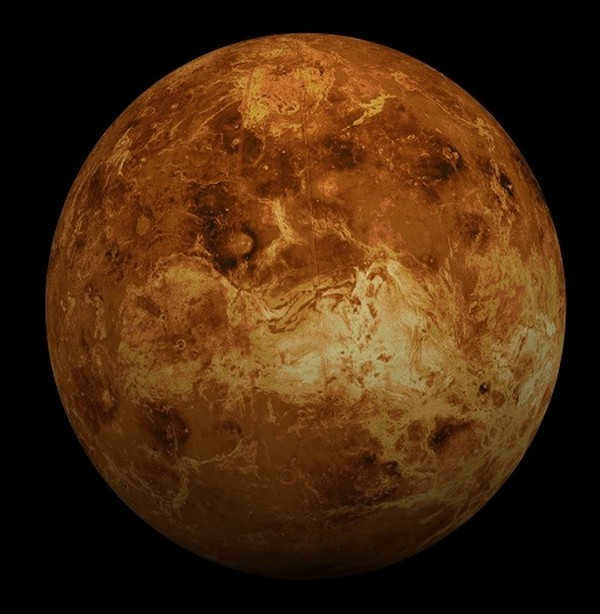
Key Features of Venus:
Time taken to orbit the Sun: 224.7 days.
Equatorial diameter: 12104 km.
Time taken to rotate (revolve around its axis): 243 days.
Average surface temperature: 480 degrees.
Composition of the atmosphere: dense, primarily carbon dioxide.
Number of major satellites: 0.
Earth, the third planet in the solar system, ranks in terms of size
Earth is believed to have originated from a gas and dust cloud, similar to the other planets in our solar system. Through collisions between gas and dust particles, the planet gradually formed. At one point, the surface temperature soared to 5,000 degrees Celsius before eventually cooling down and developing a solid rocky crust. However, the interior of the Earth still maintains a relatively high temperature of 4,500 degrees Celsius. The rocks within the Earth’s interior are in a molten state, and during volcanic eruptions, they erupt onto the surface. Only on land can we find water, which is a crucial factor in supporting life. Earth’s proximity to the Sun provides it with the necessary heat and light, while also maintaining a safe distance to prevent it from burning up.
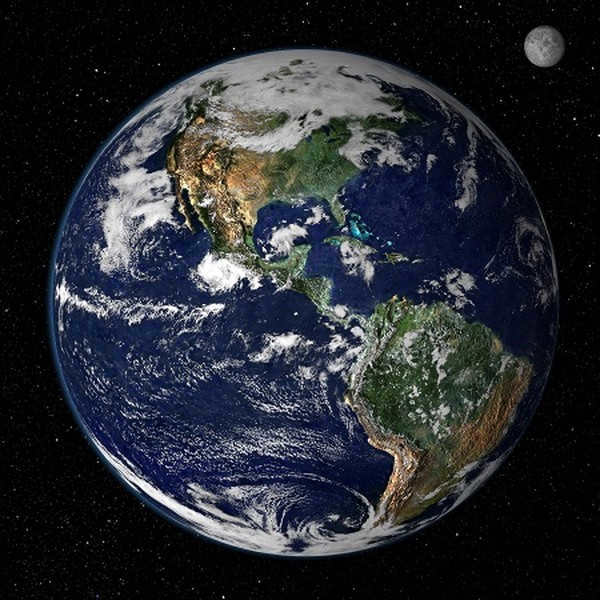
Distinctive Features of Earth:
The time it takes for Earth to complete one orbit around the Sun is approximately 365.3 days.
Earth has a diameter of 12,756 kilometers at the equator.
The planet completes one rotation, or revolution around its axis, every 23 hours and 56 minutes.
The average surface temperature of Earth is around 22 degrees Celsius.
Earth’s atmosphere consists mainly of nitrogen and oxygen.
The Moon is Earth’s primary satellite.
Mars is the fourth planet in the solar system
Due to its resemblance to Earth, there was a belief that life could exist on Mars. However, a spacecraft that landed on the planet’s surface discovered no evidence of life. Mars is positioned as the fourth planet in the order of the solar system.
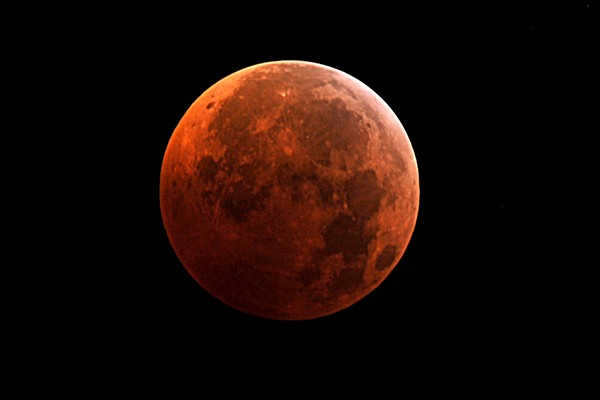
Distinctive features of the planet Mars:
Duration of orbit around the Sun: 687 days.
Equatorial diameter of the planet: 6794 kilometers.
Period of rotation (revolution around the axis): 24 hours 37 minutes.
Average surface temperature: -23 degrees.
Composition of the planet’s atmosphere: primarily carbon dioxide and rarefied.
Main natural satellites in sequential order: Phobos, Deimos.
Jupiter is the 5th planet in the solar system.
Jupiter, along with Saturn, Uranus, and Neptune, is composed primarily of hydrogen and other gases. In terms of size, Jupiter is over 10 times larger than Earth in terms of diameter, more than 300 times larger in terms of mass, and more than 1,300 times larger in terms of volume. In fact, it is more than twice as massive as all the other planets in the solar system combined. Interestingly, if Jupiter were to acquire an additional 75 times its current mass, it would have enough mass to become a star!
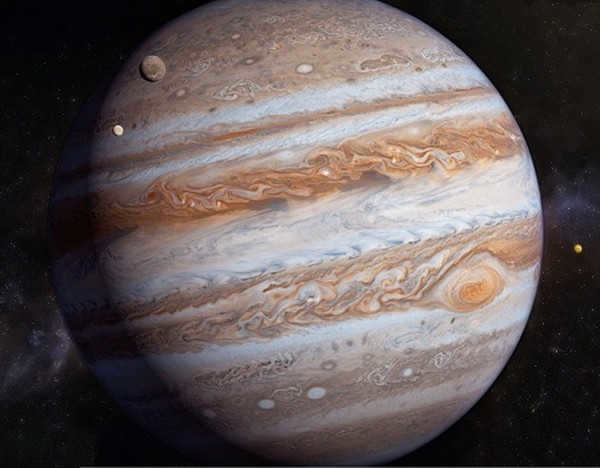
Key Characteristics of Jupiter:
Orbit Period around the Sun: 11 years 314 days.
Equatorial Diameter of the planet: 143,884 km.
Rotation Period (revolution around the axis): 9 hours 55 minutes.
Average Surface Temperature: -150 degrees Celsius.
Number of Satellites: 16 (+ rings).
Major Moons in order: Io, Europa, Ganymede, Callisto.
Saturn, the second largest planet in the solar system, captivates observers with its remarkable ring system composed of ice, rock, and dust encircling the planet. The planet boasts three primary rings, which stretch out to a diameter of 270,000 km, although their thickness is only around 30 meters.
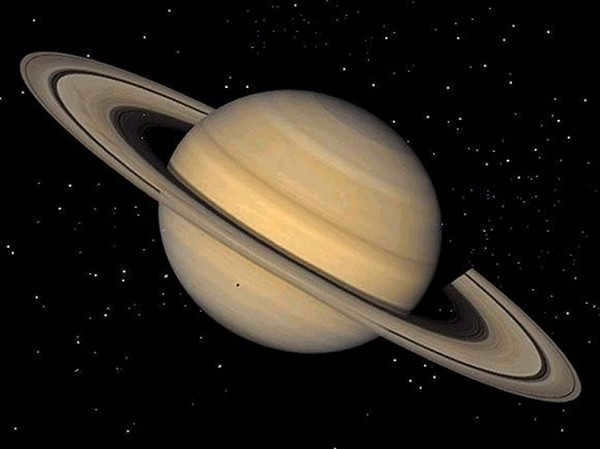
Unique Features of Saturn:
The time it takes for Saturn to orbit around the Sun is approximately 29 years and 168 days.
The equatorial diameter of Saturn is about 120,536 kilometers.
It takes Saturn approximately 10 hours and 14 minutes to complete one rotation around its axis.
The average surface temperature of Saturn is -180 degrees Celsius.
The atmosphere of Saturn is primarily composed of hydrogen and helium.
Saturn has a total of 18 satellites, including its iconic rings.
Uranus is the seventh planet in our solar system.
Uranus stands out as a distinctive celestial body within our solar system. What sets it apart is its unique rotational axis, which is tilted on its side. Unlike other planets, Uranus “lies on its side” as it orbits the Sun. Additionally, Uranus possesses a system of rings, although they are less visible compared to other ringed planets. Notably, in 1986, the spacecraft Voyager-2 had the incredible opportunity to capture images of Uranus from a close distance of 64,000 km during its six-hour encounter with the planet.
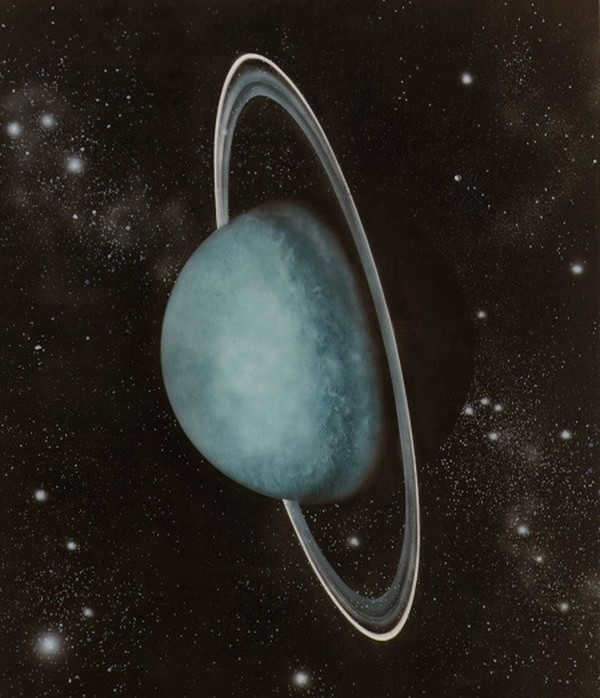
Distinctive Features of Uranus:
Orbital Period: 84 years 4 days.
Equatorial Diameter: 51118 km.
Rotation Period (Axis Revolution): 17 hours 14 minutes.
Surface Temperature: -214 degrees Celsius (average).
Atmosphere Composition: primarily hydrogen and helium.
Number of Satellites: 15 (+ rings).
Principal Satellites: Titania, Oberon.
Neptune, the eighth planet in our solar system
Currently, Neptune holds the distinction of being the farthest planet from the sun in our solar system. Its existence was initially predicted through mathematical calculations before being confirmed through observations using a telescope. In 1989, the Voyager 2 spacecraft conducted a flyby of Neptune, capturing stunning images of its vibrant blue surface and its largest moon, Triton.
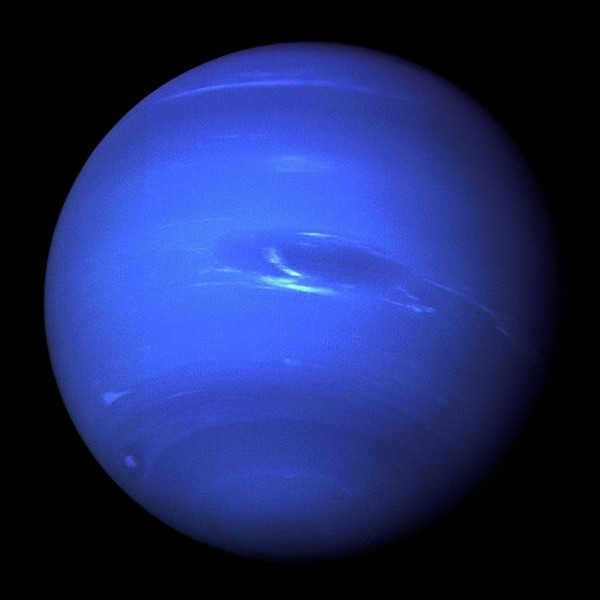
Distinctive Features of Neptune:
The time it takes for Neptune to complete one revolution around the Sun is 164 years and 292 days.
The diameter at the equator of Neptune measures 50538 kilometers.
Neptune’s rotation period, or the time it takes for it to complete one revolution around its axis, is 16 hours and 7 minutes.
The average surface temperature of Neptune is -220 degrees Celsius.
The predominant elements in Neptune’s atmosphere are hydrogen and helium.
Are there 8 or 9 planets in the solar system?
In the past, astronomers considered there to be 9 planets in the solar system, including Pluto along with the others. However, in the 21st century, scientists were able to demonstrate that Pluto is not actually a planet, resulting in a total of 8 planets in our solar system.
Nowadays, if someone were to ask you how many planets are in the solar system, you can confidently answer that there are 8 planets. This has been officially recognized since 2006. To visualize the order of the planets in our solar system, refer to the provided image. Do you believe that perhaps removing Pluto from the list of planets was a result of scientific bias?
How many planets are there in the Solar System: video, watch it for free
The Earth is a satellite of the Sun in the vastness of space, continuously orbiting around this vital source of warmth and illumination that enables life to thrive on our planet. Among the numerous celestial bodies that we regularly observe, the Sun and the Moon, our neighboring planets shine the brightest. These celestial entities, which include Earth, are part of the nine worlds that orbit the Sun. The Sun, with a radius of 700 thousand kilometers, which is 100 times larger than the Earth’s radius, is at the center of this wondrous system. The planets, although they may resemble stars, are actually much smaller and dimmer. They are visible to us only because they reflect the Sun’s rays, which appear incredibly bright due to their proximity to Earth compared to the distant stars. However, even with the aid of our most advanced telescopes, if we were to venture towards the nearest star, we would not be able to observe these Sun’s satellites.
Since 1962, spacecraft have successfully explored planets and their moons. They have studied the atmospheres and surfaces of Venus and Mars, photographed the surface of Mercury and the cloud cover of Venus, Jupiter, Saturn, and the entire surface of the Moon. They have also obtained images of the moons of Mars, Jupiter, Saturn, and the rings of Saturn and Jupiter. Descent spacecraft have investigated the physical and chemical properties of rocks on the surfaces of Mars, Venus, and the Moon (samples of lunar rocks were brought back to Earth and thoroughly studied).
Planets are categorized into two groups based on their physical characteristics: terrestrial-type planets (Mercury, Venus, Earth, Mars) and giant planets (Jupiter, Saturn, Uranus, Neptune). Although little is known about Pluto, it appears to have a structure more similar to that of the terrestrial planets.
March 13, 1781 marked the date when William Herschel, an astronomer from England, made the groundbreaking discovery of Uranus, the seventh planet in our solar system. Another significant discovery occurred on March 13, 1930, when Clyde Tombaugh, an American astronomer, identified Pluto as the ninth planet in our solar system. For many years, it was widely accepted that there were nine planets in our solar system. However, in 2006, the International Astronomical Union made the controversial decision to reclassify Pluto and remove its planet status.
There have been a total of 60 natural satellites of Saturn that have been identified so far, with the majority being found through spacecraft exploration. These satellites are primarily composed of a combination of rocks and ice. The largest of these satellites, known as Titan, was first discovered in 1655 by Christiaan Huygens and it is actually larger in size than the planet Mercury. Titan has a diameter of approximately 5,200 kilometers and it completes a full orbit around Saturn every 16 days. One unique feature of Titan is its incredibly dense atmosphere, which is 1.5 times larger than that of Earth and is primarily made up of 90% nitrogen, along with a significant presence of methane.
In May 1930, the International Astronomical Union officially designated Pluto as a planet. Initially, it was believed that Pluto had a mass similar to that of Earth. However, it was later discovered that Pluto’s mass is nearly 500 times smaller than Earth’s, and even less than the Moon’s. Pluto’s mass is equivalent to 1.2 x 10^22 kg (0.22 times the mass of Earth). The average distance between Pluto and the Sun is 39.44 astronomical units (5.9 x 10^12 km), and its radius is approximately 1.65 thousand kilometers. Pluto takes 248.6 years to complete one orbit around the Sun, and it rotates on its axis every 6.4 days. Scientists believe that Pluto’s composition consists of rock and ice, and it possesses a thin atmosphere comprised of nitrogen, methane, and carbon monoxide. In addition, Pluto has three moons: Charon, Hydra, and Nycta.
During the late 20th and early 21st centuries, numerous discoveries were made in the outer region of our solar system. It became evident that Pluto is just one of the many sizable objects found in the Kuiper Belt. Additionally, there is at least one object in the belt, Erida, that is larger and 27% more massive than Pluto. This has led to the reconsideration of Pluto’s classification as a planet. On August 24, 2006, the XXVI General Assembly of the International Astronomical Union (IAU) decided to officially designate Pluto as a “dwarf planet” rather than a traditional planet.
During the conference, a fresh interpretation of a planet was formulated, wherein planets are defined as celestial bodies that orbit a star (and are not stars themselves), possess a hydrostatic equilibrium shape, and effectively “sweep” the space near their orbit clear of other, smaller objects. Dwarf planets, on the other hand, are objects that revolve around a star, maintain a hydrostatic equilibrium shape, but do not entirely clear the surrounding space and are not satellites. Planets and dwarf planets are two distinct categories of entities within the Solar System. Any other bodies orbiting the Sun that are not satellites will be referred to as small objects of the Solar System.
On June 11, 2008, the IAU made an official statement about the addition of a new term called “plutoid”. Plutoids refer to celestial objects that revolve around the Sun in an orbit that is larger than Neptune’s orbit, have enough mass to be nearly spherical due to gravitational forces, and do not clear the space around their orbit (meaning that there are many smaller objects also orbiting around them).
Due to the difficulty in determining the shape of distant objects like plutoids and their classification as dwarf planets, scientists have proposed temporarily referring to all objects with a absolute asteroidal magnitude brighter than +1 as plutoids. If it is later discovered that an object classified as a plutoid is not a dwarf planet, it will be removed from this status, but its assigned name will still remain. The dwarf planets Pluto and Erida have already been categorized as plutoids. Makemake was added to this category in July 2008, and Haumea was added on September 17, 2008.
This information is sourced from open sources.
Satellites orbiting the planets in the solar system: comprehensive data on the precise count of satellites for both inner and outer system planets, as well as information on the largest and smallest satellites, complete with detailed descriptions, captivating photos, and cutting-edge research.
Throughout the course of many centuries, humanity has had the privilege of observing the Earth’s lone satellite, the Moon. However, it was not until the groundbreaking year of 1610 that Galileo Galilei made an astonishing discovery, revealing the existence of four satellites orbiting the planet Jupiter. This groundbreaking revelation not only expanded our understanding of celestial bodies but also confirmed the presence of moons in our very own solar system. Yet, the question remains: just how many satellites do we have orbiting around our magnificent collection of planets?
What is the total number of satellites in the solar system?
Estimating the exact number of satellites in the solar system is a challenging task due to the inclusion of both confirmed and candidate satellites. Currently, there are approximately 173 confirmed satellites, but if we also consider the dwarf planets, the count reaches 182. For a comprehensive analysis of each satellite associated with the solar planets, please refer to the table below.
A recent survey conducted by VTsIOM for the Day of Russian Science (February 8) revealed that 32 percent of Russians hold the misconception that the Sun is a satellite of the Earth. Surprisingly, this number has actually increased since 2007. Interestingly, it is the female population that seems to struggle the most with knowledge related to radiation, antibiotics, and the Earth-Sun system. In fact, women were more likely than men to refer to the Sun as a satellite of the Earth. However, there was an interesting exception to this trend. The survey found that 29 percent of men and 23 percent of women believe that lasers “focus sound waves.”
The first “satellite” of the Earth is known as a Trojan. Trojans are celestial bodies that “inhabit” the Lagrangian points L4 and L5 of the planet-sun system. These points are positioned to form an equilateral triangle with the Sun and the planet. While Neptune, Jupiter, and Mars have Trojan asteroids, the Earth has yet to discover any satellites.
Grids and all electrical systems. A massive electromagnetic disaster will be unleashed upon our planet without any prior notice, catching Earth off guard and unprepared for such a devastating event. Enormous solar flares erupting from the Sun, also known as coronal ejections, will trigger unprecedented geomagnetic storms that will result in a global catastrophe. The warning signal transmitted from a satellite observing the sun will finally reach the space research center in Houston. At this point, humanity will have to rely on its resources and knowledge to face this immense challenge.
An amateur American astronomer in Arizona recently made the exciting discovery of a new natural satellite orbiting the Earth every 50 days. It is speculated that this celestial body could potentially become the Earth’s third natural satellite if previous predictions do not come to fruition. It is important to note that the Moon is currently recognized as our planet’s first satellite, while the second is the moon.
The Sun, which is the central star of our solar system, is known to have different planets orbiting around it. It has been estimated to be approximately 5 billion years old and is classified as a yellow dwarf due to its relatively small size. Unlike other stars, the Sun does not consume its fuel quickly and has reached the midpoint of its life cycle. In about 5 billion years, the equilibrium of gravitational forces will be disrupted, causing the star to expand in size and gradually increase in temperature. During this process, the Sun will convert its hydrogen into helium and expand to three times its current size. Eventually, the star will cool down and shrink. As of now, the Sun is composed mostly of hydrogen (90%) with a small amount of helium (10%).
A general overview of the solar system
In order to understand the satellites of the Sun, it is important to have a clear understanding of certain definitions: what constitutes a star, a planet, a satellite, and so on. A star is a celestial body that emits light and energy into space. This ability is made possible by thermonuclear reactions and the compressive forces of gravity. In our solar system, there is only one star – the Sun. Surrounding it are eight planets that orbit in its gravitational field.
A planet, in modern terms, is a celestial body that revolves around a star and has a roughly spherical shape. Unlike stars, planets do not emit light themselves, but rather reflect it. Additionally, planets are characterized by the absence of other large celestial bodies in their immediate orbits.
On the contrary, a satellite is an entity that orbits around larger celestial bodies such as stars or planets. The gravitational force of these massive celestial bodies keeps the satellite in its orbit. When considering the number of satellites that the Sun possesses, it is important to acknowledge that this inventory encompasses not only planets but also asteroids, comets, and meteorites. Attempting to tally them all would be a nearly impossible feat.
Planets
Until recently, the consensus was that our solar system consists of nine planets. However, after extensive deliberation, Pluto was removed from this roster. Nevertheless, it remains an integral part of our celestial family.
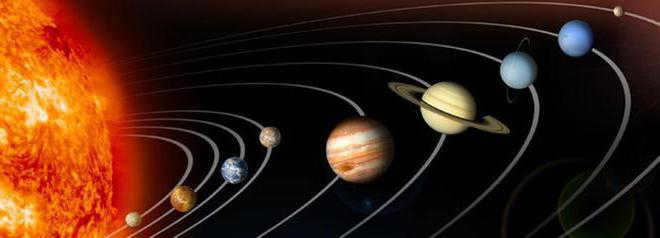
The Sun holds the 8 major planets in their respective orbits. The Sun can also have celestial bodies revolving around it, which can be quite large objects. All planets can be divided into 2 groups. The first group consists of the inner satellites of the Sun, while the second group consists of the outer satellites.
The terrestrial planets belong to the first group and include:
- Mercury (the closest to the Sun).
- Venus (the hottest planet).
- Earth.
- Mars (the most accessible object for exploration).
These planets are composed of metals and silicates, and their surfaces are solid. The outer group consists of gas giants, which are characterized by a high content of hydrogen and helium. These planets are like systems in themselves.
When it comes to the number of satellites orbiting the Sun, it is important to acknowledge the celestial objects that revolve around the planets. During ancient times in Greece, the known planets were Venus, Mercury, the Sun, Mars, the Moon, Jupiter, and Saturn. It wasn’t until the 16th century that Earth was included in this list. In human understanding, the Sun holds a central role in our solar system. Conversely, the Moon is recognized as a satellite of Earth.
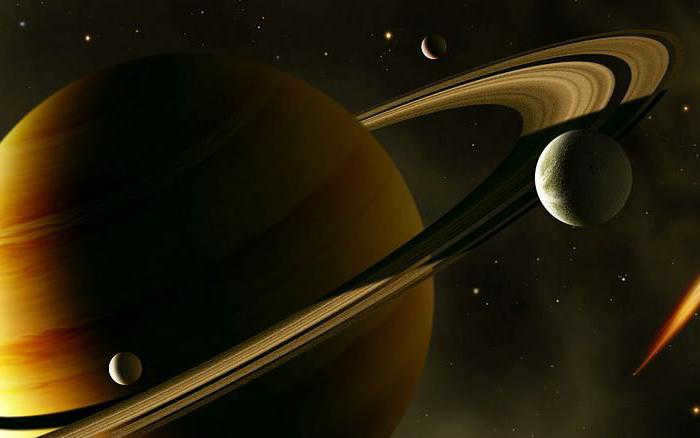
With the development of more advanced technology, it has been determined that nearly all planets possess their own satellites. Venus and Mercury are the only exceptions. Currently, there are approximately 60 acknowledged satellites orbiting the planets, each varying in size. Leda is recognized as the smallest among them, measuring just 10 kilometers in diameter.
The majority of these celestial bodies orbiting gas giants were discovered through the use of automated space technology, which provided scientists with photographic evidence of their existence.
Mercury and Venus
The two celestial bodies closest to our star, the Sun, are Mercury and Venus. Mercury, which is a satellite of the Sun, holds the distinction of being the smallest planet in our solar system. On the other hand, Venus is slightly larger than Mercury, but both of these planets do not have any satellites of their own.
Mercury has a particularly thin atmosphere composed mostly of helium. It completes one orbit around the Sun in 88 Earth days. However, its rotation period on its axis is much shorter, taking only 58 days by our standards. The temperature on the side facing the Sun can reach a scorching +400 degrees, while at night, it plummets to a chilling -200 degrees.

The composition of Venus’ atmosphere is primarily hydrogen, with traces of nitrogen and oxygen. This leads to the greenhouse effect, which causes the surface temperature to reach an astonishing +480 degrees. Surprisingly, this is even hotter than Mercury. Due to its close proximity to Earth, Venus is easily observable from our planet.
Planet Earth
Our planet, known as Earth, stands out as the largest member of the Earth group. It possesses a multitude of unique characteristics that set it apart from other celestial bodies. Notably, Earth boasts the largest orbiting satellite among the first 4 planets in proximity to a star. This satellite, which is none other than our very own planet, possesses a distinctive atmosphere that is unlike any other. It is this very atmosphere that has made life as we know it possible.
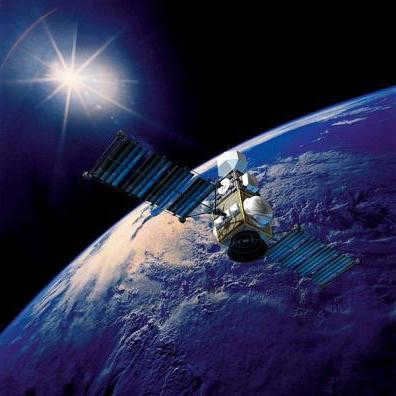
About 71% of the Earth’s surface is made up of water, while the remaining 29% consists of land. The Earth’s atmosphere is primarily composed of nitrogen, along with oxygen, carbon dioxide, argon, and water vapor.
In contrast, the Moon, Earth’s satellite, lacks an atmosphere altogether. It is devoid of wind, sound, and weather, presenting a barren, rocky landscape dotted with craters. On Earth, meteorite impact sites are gradually eroded by various factors such as wind and weather, but the Moon lacks these forces, allowing its past history to be preserved in pristine detail.
Mars
Mars is the fourth planet in the solar system, located in the Earth group. It is famously known as the Red Planet due to the abundant presence of iron oxide in its soil. In many ways, Mars bears a resemblance to Earth, making it a fascinating subject of scientific study. Unlike Earth, Mars has a longer year, taking 678 Earth days to orbit the Sun. Scientists have long speculated about the possibility of past life on Mars, but so far, conclusive evidence has not been found. Mars has two natural satellites, Phobos and Deimos, which are smaller in size compared to our Moon.

The temperature on this planet is colder than on Earth. It drops to 0 degrees at the equator and -150 degrees at the poles. Astronaut missions are already possible on this planet, and a spaceship can reach it in four years.
In the past, rivers used to flow on the planet’s surface, indicating the presence of water. However, now there are ice caps made of atmospheric carbon dioxide at the poles. It is possible that water is frozen in large clumps beneath the planet’s surface, according to scientists.
Gas giants
The gas giants are the largest celestial bodies that revolve around the Sun, located beyond the planet Mars. These planets, which are satellites in their own right, have been extensively studied using a variety of techniques. The most massive object in our solar system is Jupiter, which is over 2.5 times more massive than all the other planets combined. Composed primarily of helium and hydrogen, similar to our own star, Jupiter also emits heat. However, in order for Jupiter to be classified as a star, it would need to become about 80 times more massive. Jupiter is accompanied by 63 satellites.
Saturn, on the other hand, is slightly smaller than Jupiter but is famous for its magnificent rings. These rings consist of icy particles of varying diameters. The density of Saturn is actually lower than that of water, which is quite remarkable. Saturn has a total of 62 satellites orbiting around it.

Uranus and Neptune are located even further away compared to the previous two planets. They were discovered using the assistance of a telescope. These two planets are characterized by significant amounts of high-temperature variations of ice, earning them the nickname of the “Ice Giants.” Uranus is accompanied by 23 satellites, while Neptune has 13 satellites.
Pluto
The sun’s satellites are also accompanied by a small celestial body known as Pluto. From 1930 to 2006, it held the designation of a planet. However, after extensive deliberation, scientists reached a consensus that it does not meet the criteria to be classified as a planet. Instead, Pluto falls into a distinct category. According to the current planetary classification, it is considered a prototype. The surface of this object is covered in frozen ice composed of methane and nitrogen. Pluto is accompanied by 1 satellite.
After examining the primary satellites of the Sun, it must be noted that this constitutes an entire system comprised of a multitude of diverse entities. These objects possess varying characteristics and indicators. What unifies all of these objects is the force that ensures their consistent rotation around their central star.
Relatively small celestial bodies that orbit larger planets, known as natural satellites, are the focus of a scientific field called planetology.
In the 1970s, astronomers hypothesized that Mercury had multiple dependent celestial bodies due to the detection of ultraviolet radiation in its vicinity. However, it was later discovered that the light originated from a distant star.
With the aid of modern technology, a more comprehensive examination of the Sun’s closest planet is now possible. Presently, all planetologists unanimously assert that it lacks any satellites.
Satellites orbiting Venus
Venus is often referred to as Earth’s twin due to their similar compositions. However, when it comes to natural celestial objects, the planet named after the goddess of love is more similar to Mercury. These two planets in our solar system are distinct in that they lack any known satellites.
It is speculated by astrologers that Venus might have had satellites in the past, but none have been discovered as of yet.
What is the number of natural satellites orbiting Earth?
Earth is accompanied by numerous satellites, but it possesses only one natural satellite that is universally known – the Moon.
The Moon’s size is approximately one-fourth the diameter of Earth, measuring 3475 km. It stands out as the sole celestial body with such substantial proportions in relation to its “host”.
Interestingly, despite its large size, the Moon has a relatively low mass of 7.35×10²² kg, indicating a low density. From Earth, one can observe numerous craters on its surface even without the aid of special equipment.
What are the moons of Mars?
Mars is a relatively small planet, often referred to as the “red planet” due to its crimson hue. This distinct color comes from the presence of iron oxide in its composition. Currently, Mars is home to two natural satellites.
Discovered by Asaph Hall in 1877, these satellites are called Deimos and Phobos. They are the smallest and darkest objects within our solar system.
Deimos, which derives its name from the ancient Greek god of panic and terror, has been observed to be gradually drifting away from Mars. On the other hand, Phobos, named after the god of fear and chaos, is the only satellite that orbits so closely to its “host”, at a distance of 6000 km.
The surfaces of Phobos and Deimos are richly adorned with craters, dust, and various loose rocks.
Jupiter’s Moons
Currently, Jupiter has a total of 67 moons, making it the planet with the most moons. The discovery of some of these moons can be credited to Galileo Galilei, who first observed them in 1610.
Among the notable moons that orbit Jupiter are:
- Adrastea, which has a diameter of 250x147x129 km and a mass of approximately 3.7-10^16 kg;
- Metis, measuring 60x40x35 km and weighing around 2-10^15 kg;
- Phoebe, with dimensions of 116x99x85 km and a mass of approximately 4.4-10^17 kg;
- Amalthea, which measures 250x148x127 km and has a mass of 2-10^18 kg;
- Io, with a mass of 9-10^22 kg and dimensions of 3660x3639x3630 km;
- Ganymede, which has a diameter of 5263 km and a mass of 1.5-10^23 kg;
- Europa, with a diameter of 3120 km and a mass of 5-10^22 kg;
- The first satellites were observed in 1610, some during the 1970s to the 1990s, and then in 2000, 2002, and 2003. The most recent ones were discovered in 2012.
Saturn and its moons
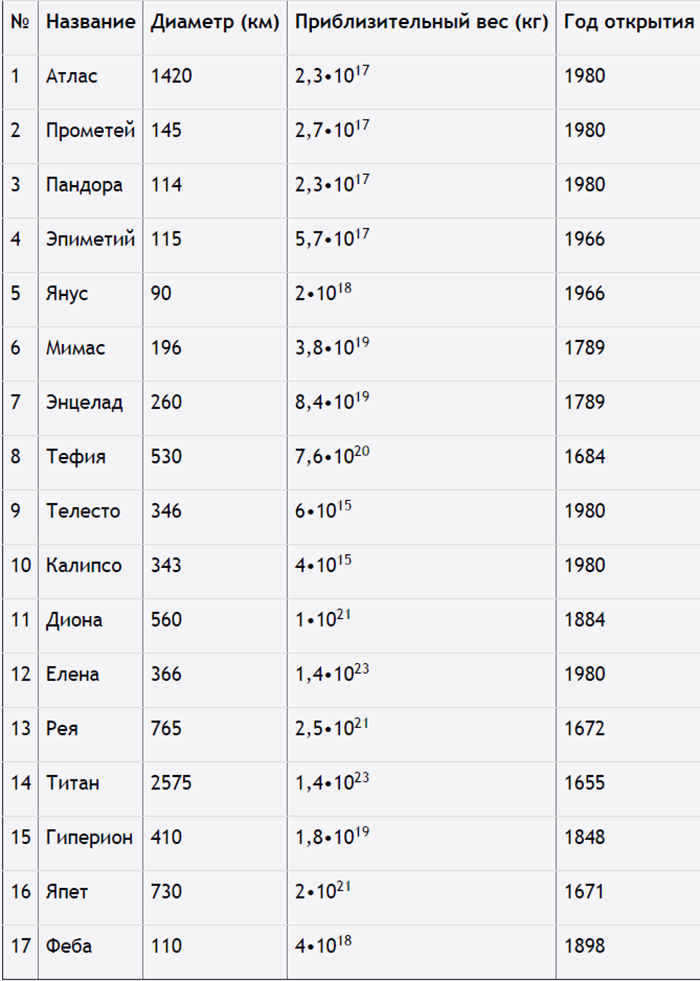
What is the number of satellites orbiting Uranus?
At present, Uranus is accompanied by a total of 27 natural celestial bodies. These satellites are given names based on characters found in famous literary works written by Alexander Pope and William Shakespeare.
Below is a list of the satellites along with a brief description for each:
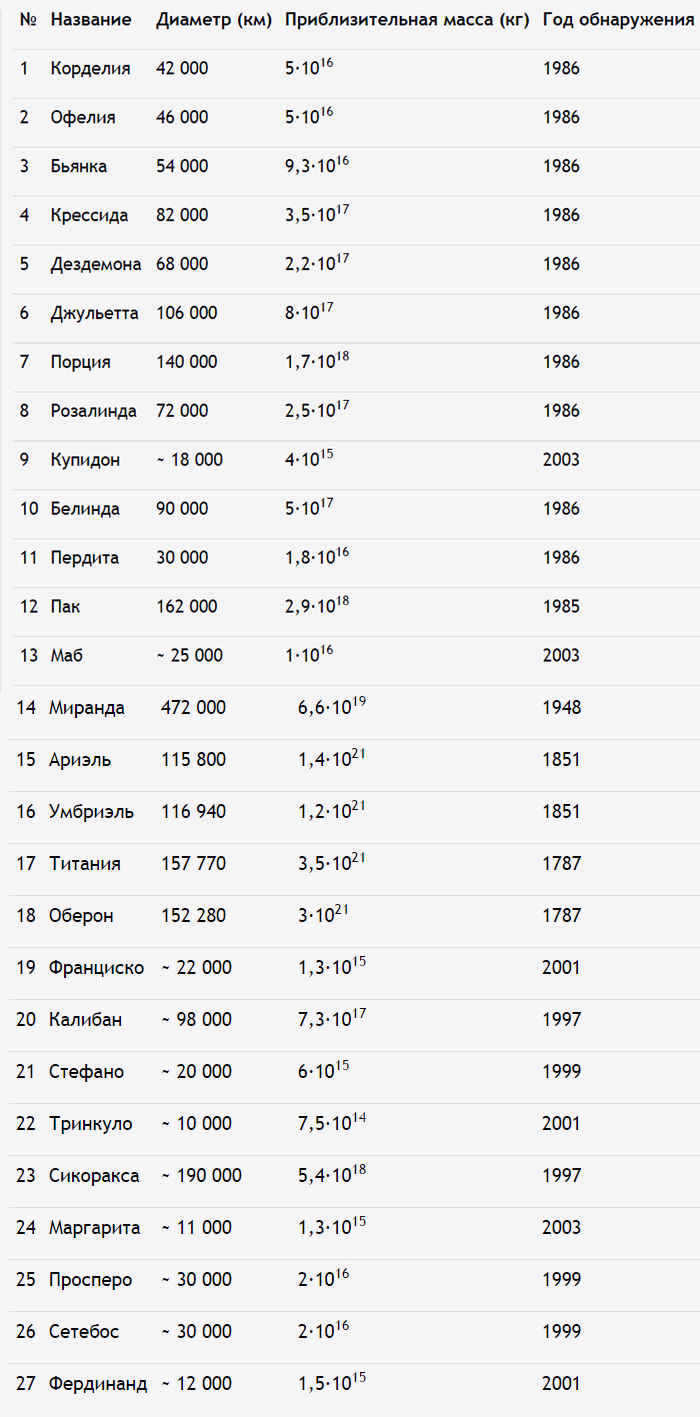
The Satellites of Neptune
Neptune, the planet whose name resembles that of the mighty god of the oceans, was identified in 1846. Unlike other planets, its discovery was made through mathematical computations rather than direct observation. Over time, additional satellites were detected, bringing the total count to 14.
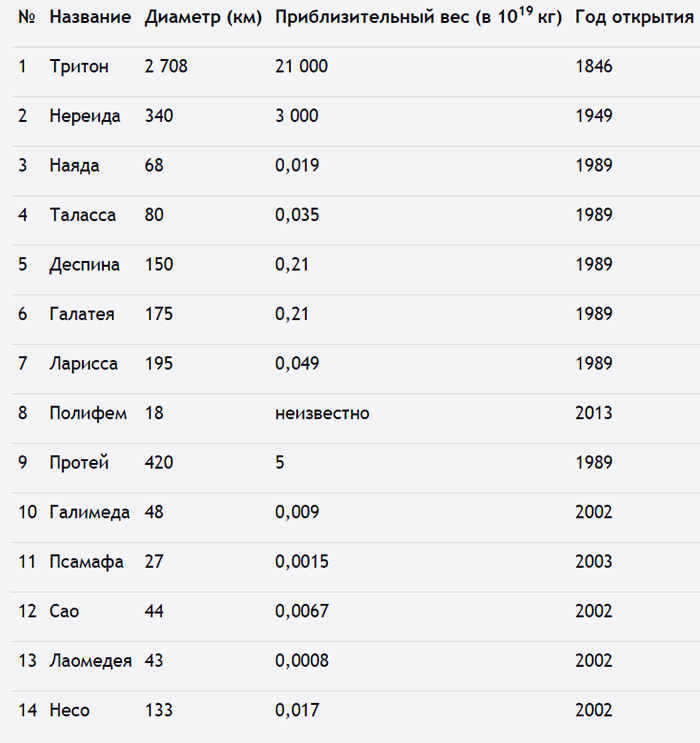
The satellites of Neptune are named after nymphs and various sea deities from Greek mythology.
The Nereid, a stunning celestial body, was first observed by Gerard Kuiper in 1949. Planetologists are currently conducting detailed studies of Proteus, which is a non-spherical object in space.
Triton, the colossal moon of Neptune, holds the record for being the coldest object in the solar system with a temperature of -240°C. It is also unique as it orbits in the opposite direction to its “host” planet.
Almost all of Neptune’s satellites feature craters and volcanoes, both fiery and icy. These natural formations eject mixtures of methane, dust, liquid nitrogen, and other substances. Therefore, it is impossible for a person to visit them without special protective gear.
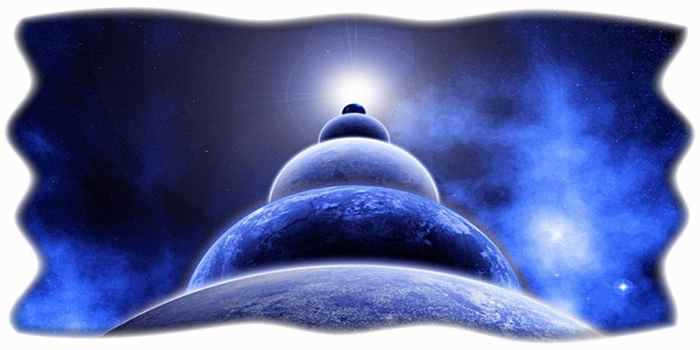
What are the “planetary satellites” and how many are there in our solar system?
Planetary satellites are celestial bodies that are smaller than the planets they orbit. The origin of these satellites remains a mystery and is a topic of great interest in modern planetology.
Currently, we know of 179 natural objects in space that function as satellites, and they are distributed as follows:
- Venus and Mercury – 0;
- Earth – 1;
- Mars – 2;
- Pluto – 5;
- Neptune – 14;
- Uranus – 27;
- Saturn – 63;
- Jupiter – 67.
As technology continues to advance, we may discover even more celestial bodies in the future. We just have to be patient and stay informed through the latest news and discoveries.
The biggest satellite in the solar system
Ganymede, a moon of the massive planet Jupiter, is considered to be the largest satellite in our solar system. Scientists estimate that its diameter is 5263 km. Following Ganymede in size is Titan, a moon of Saturn, with a diameter of 5150 km. Rounding out the top three is Callisto, which is also a moon of Jupiter and is a close neighbor to Ganymede. Callisto has a diameter of 4800 km.
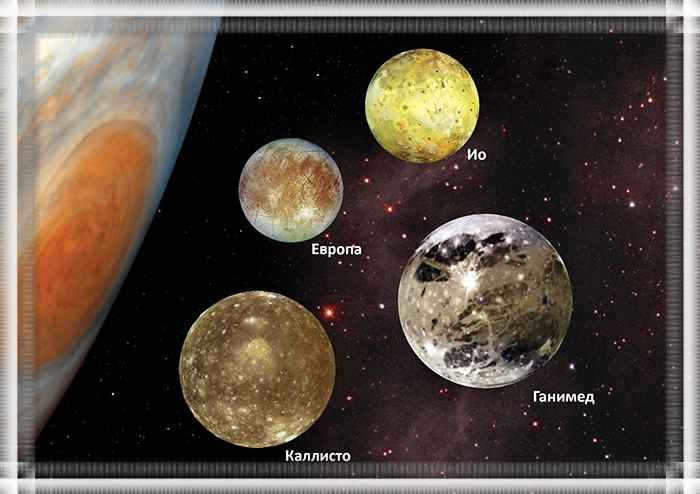
What is the purpose of satellites for planets?
Throughout history, scientists have constantly pondered the importance of satellites for planets and the impact they have on celestial bodies. By conducting thorough observations and detailed calculations, certain deductions can be made.
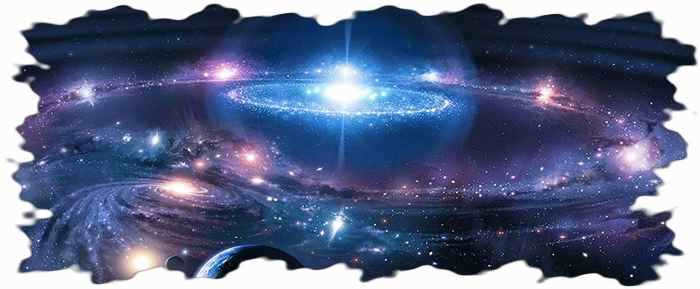
Natural satellites play a crucial role for their respective planets, as they contribute to the creation of a specific climate and act as a protective shield against potentially dangerous celestial bodies, such as asteroids and comets.
Despite their significant impact, satellites are not essential for the existence of life on a planet. This conclusion was reached by Jack Lissauer, an American scientist from the NASA Space Science Center.
On October 4, 1957, the first artificial satellite was launched into Earth’s orbit, marking the beginning of the space age in human history. Since then, artificial satellites have been instrumental in the study of celestial bodies within our galaxy.
Artificial Earth satellites (AES)
In 1957, the Soviet Union was the first country to successfully launch a satellite into Earth’s orbit. The United States followed suit a year later, becoming the second nation to achieve this feat. Subsequently, numerous countries have launched their own satellites into orbit around our planet; however, many of these nations have relied on satellites acquired from the Soviet Union, the United States, or China. Interestingly, even amateur radio operators now have the ability to launch satellites. Despite this, satellites play a crucial role in a variety of important tasks. For instance, astronomical satellites are used to study the galaxy and other celestial objects, while biosatellites are instrumental in conducting scientific experiments on living organisms in space. Meteorological satellites are utilized to predict weather patterns and monitor Earth’s climate, while navigation and communication satellites serve their respective purposes as indicated by their names. Satellites can remain in orbit for a few hours or several years, with manned spacecraft acting as short-term artificial satellites and space stations serving as long-term spacecraft that orbit Earth. Since 1957, over 5,800 satellites have been launched into space, with approximately 3,100 still in operation today. However, out of those 3,100 satellites, only around one thousand are currently functional.
ISL Artificial Satellites of the Moon
The ISL played a significant role in the exploration of the Moon. By entering the Moon’s orbit, these satellites captured high-resolution images of the lunar surface and transmitted them back to Earth. Furthermore, by altering the satellites’ trajectories, valuable information about the Moon’s gravitational field, shape, and internal structure could be gathered. The Soviet Union led the way in this field, with the launch of Luna-10, the first Soviet automatic station to orbit the Moon, in 1966. Over the following three years, five more Soviet Luna satellites and five American Lunar Orbiter satellites were successfully launched.
Artificial Satellites of the Sun
Interestingly, it wasn’t until the 1970s that artificial satellites accidentally found themselves in the vicinity of the Sun. The first of these satellites was Luna-1, which veered off course and ended up in the Sun’s orbit instead of reaching the Moon. It’s quite a feat to transition into a heliocentric orbit, as the spacecraft needs to achieve a specific velocity without surpassing certain limits. When approaching planets, the satellite can either slow down and become a satellite of that planet or speed up and venture out of the solar system entirely. Nevertheless, NASA satellites began conducting detailed measurements of solar wind parameters while orbiting the Sun near Earth’s orbit. For about ten years, a Japanese satellite observed the Sun in the X-ray range until 2001. In 2009, Russia launched a solar satellite called Koronas-Foton, which will investigate the most dynamic solar processes and monitor solar activity around the clock for the purpose of predicting geomagnetic disturbances.
The initial artificial satellites of Mars consisted of three ISMs simultaneously. The USSR launched two spacecraft, namely “Mars-2” and “Mars-3”, while the USA launched “Mariner-9”. However, it is important to note that these launches were not in competition with each other, as each satellite had its own unique objective. All three ISMs were placed in distinct elliptical orbits and carried out diverse scientific investigations, complementing one another. “Mariner-9” focused on creating a comprehensive map of Mars’ surface, whereas the Soviet satellites concentrated on studying various aspects of the planet, such as the flow of Martian solar wind, the ionosphere and atmosphere, topography, temperature distribution, the quantity of water vapor in the atmosphere, and other relevant data. Furthermore, Mars-3 made history as the first spacecraft to successfully achieve a soft landing on the Martian surface.
Artificial Satellites of Venus (ASVs)
The initial ISVs were once again Soviet spacecraft. “Venera-9” and “Venera-10” achieved orbit in 1975. Upon arrival at the planet, they were separated into satellites and planetary reentry vehicles. Thanks to the ISV radar, scientists were able to obtain highly detailed radio images, while the vehicles gently descended to the surface of Venus, capturing the world’s first photographs of another planet’s surface… The third satellite, Pioneer-Venera-1, was launched three years later by the American team.

